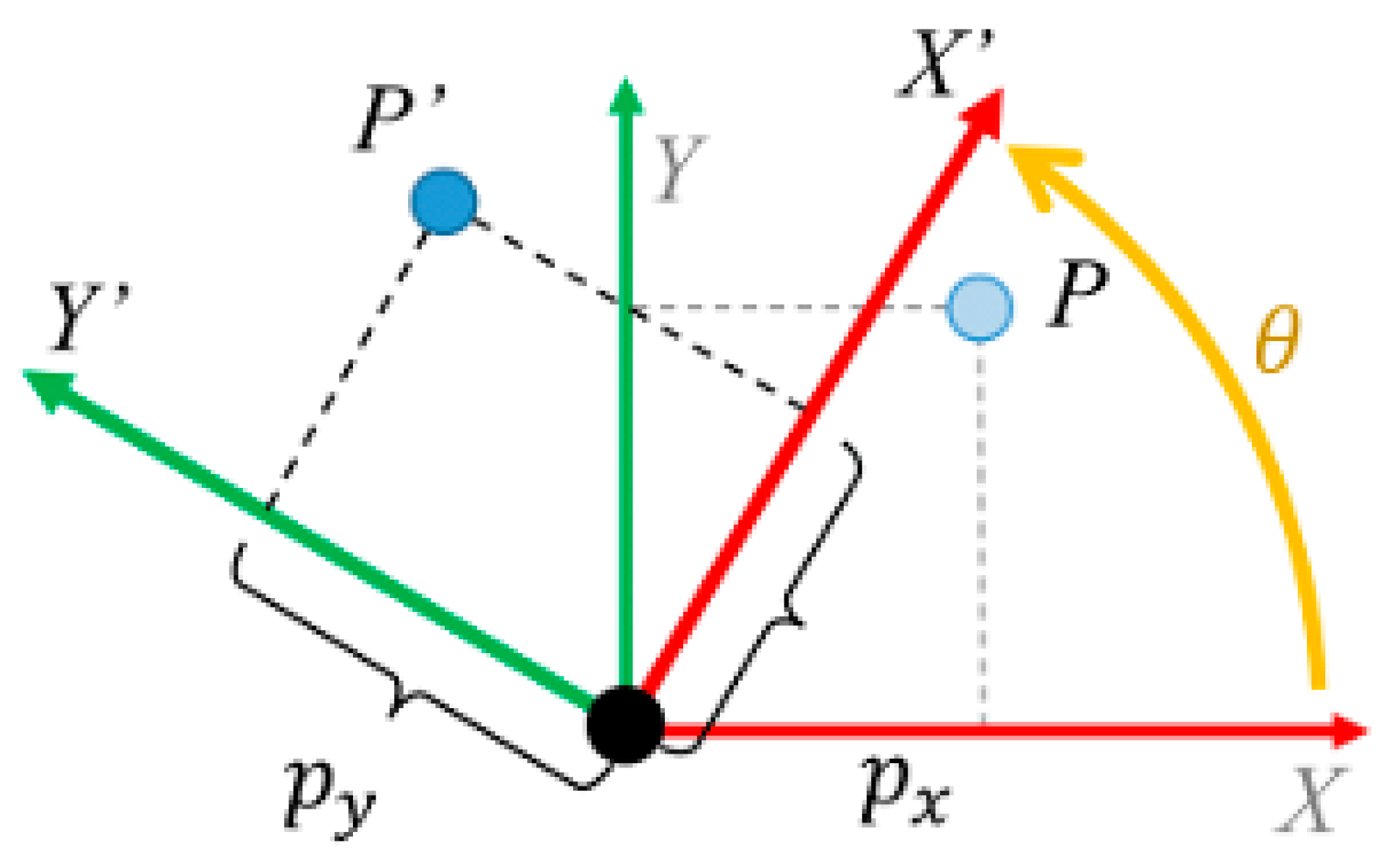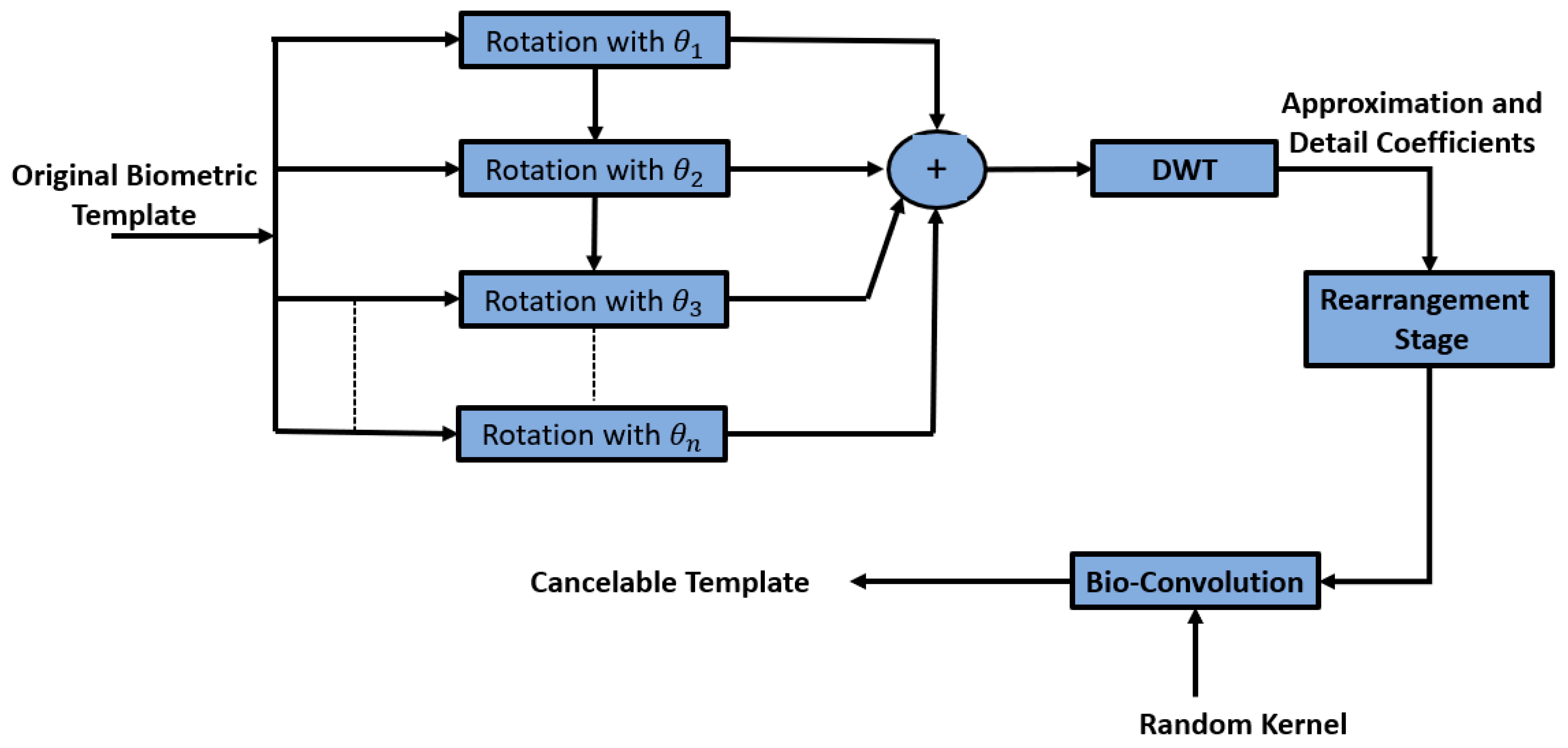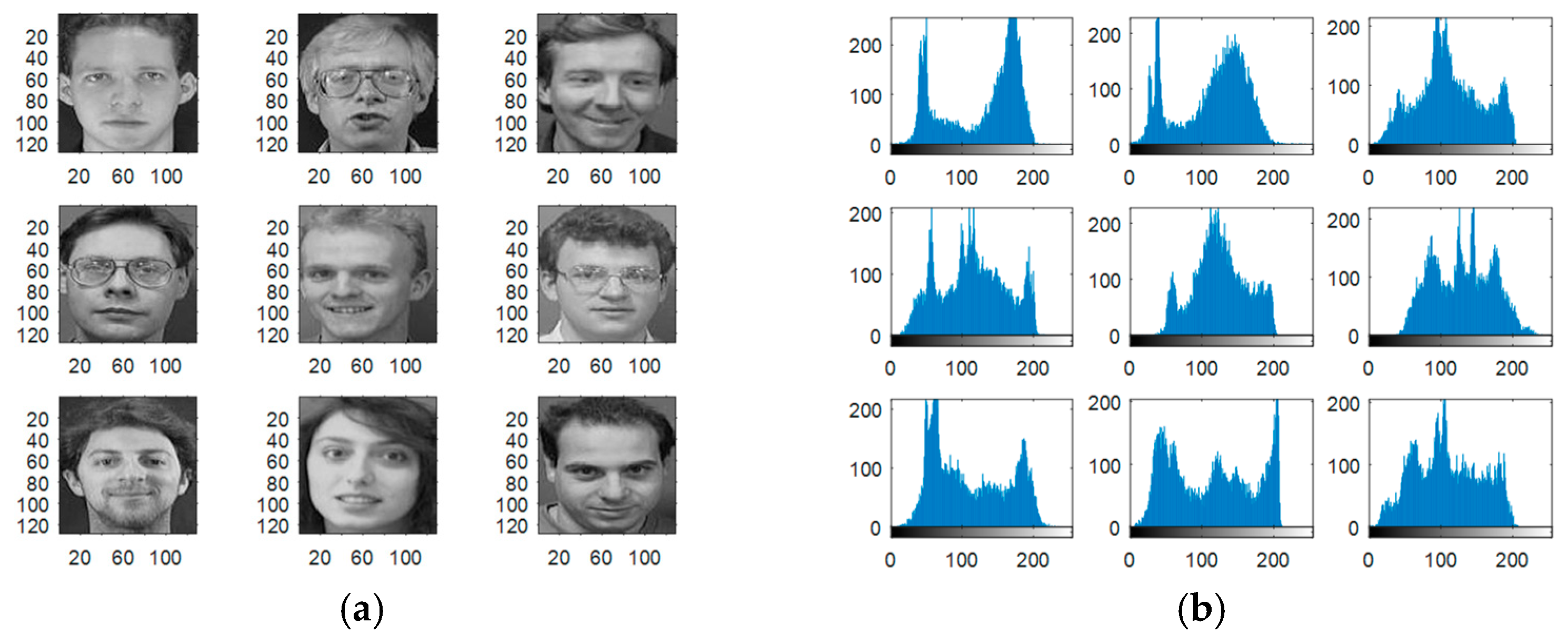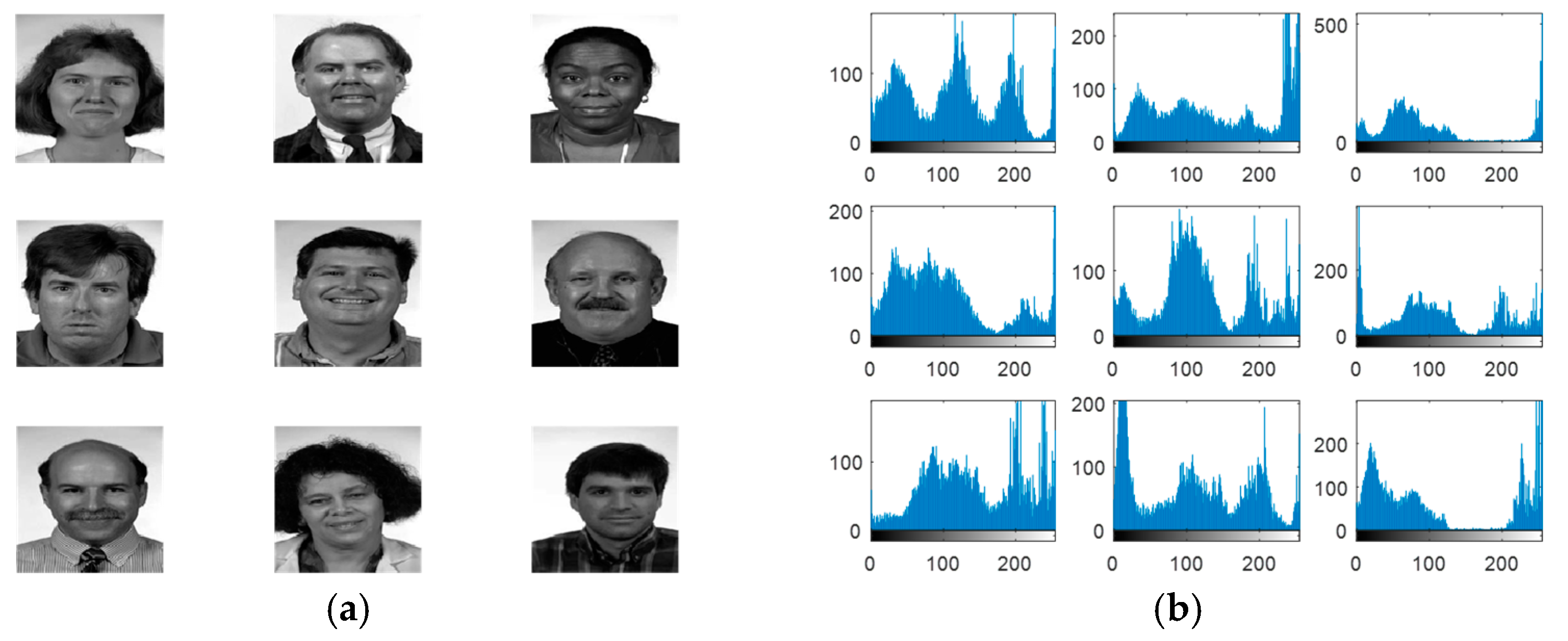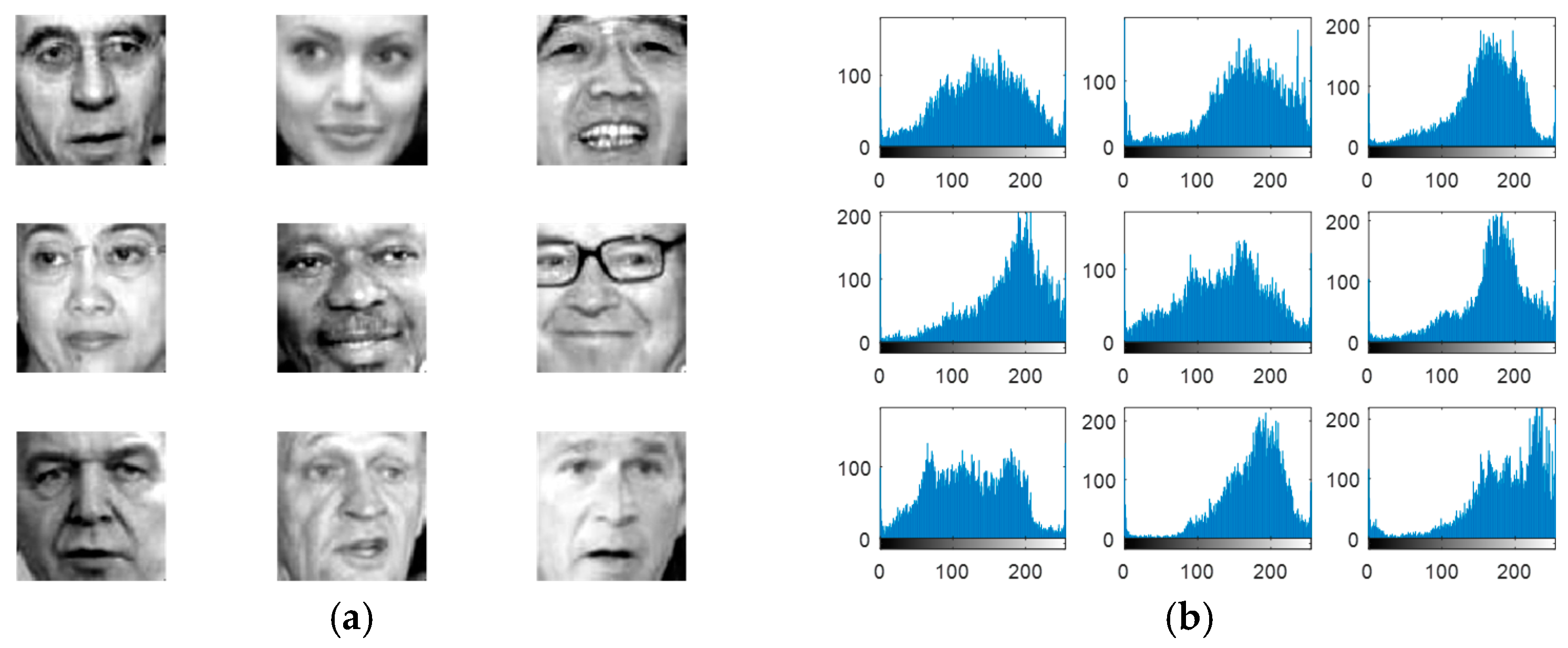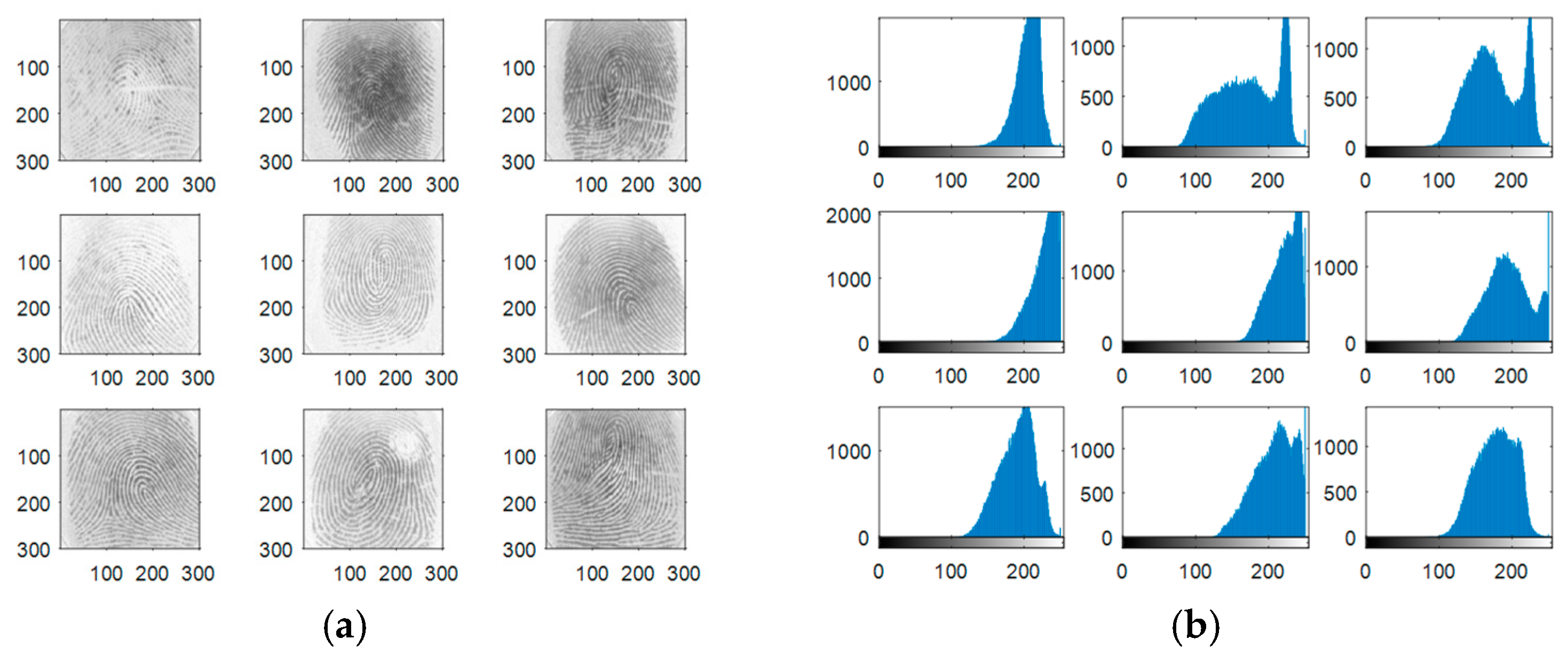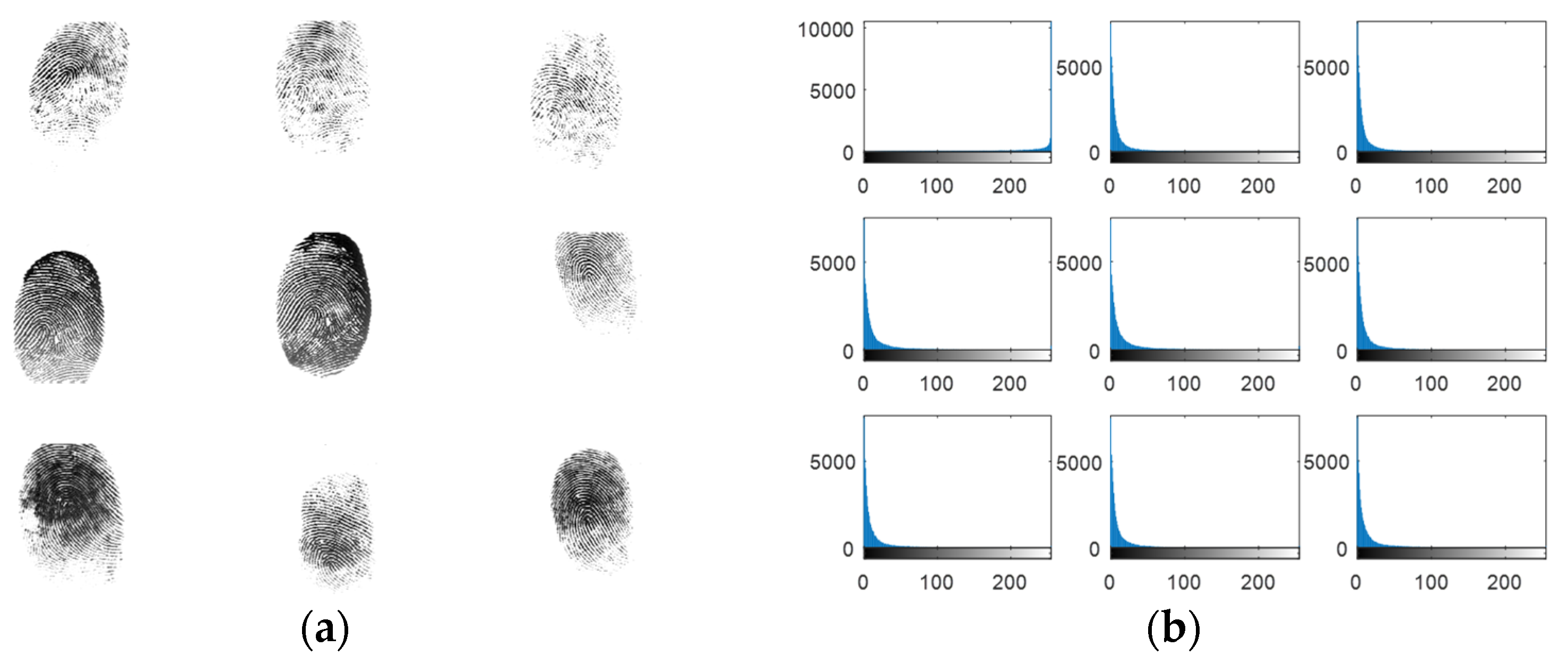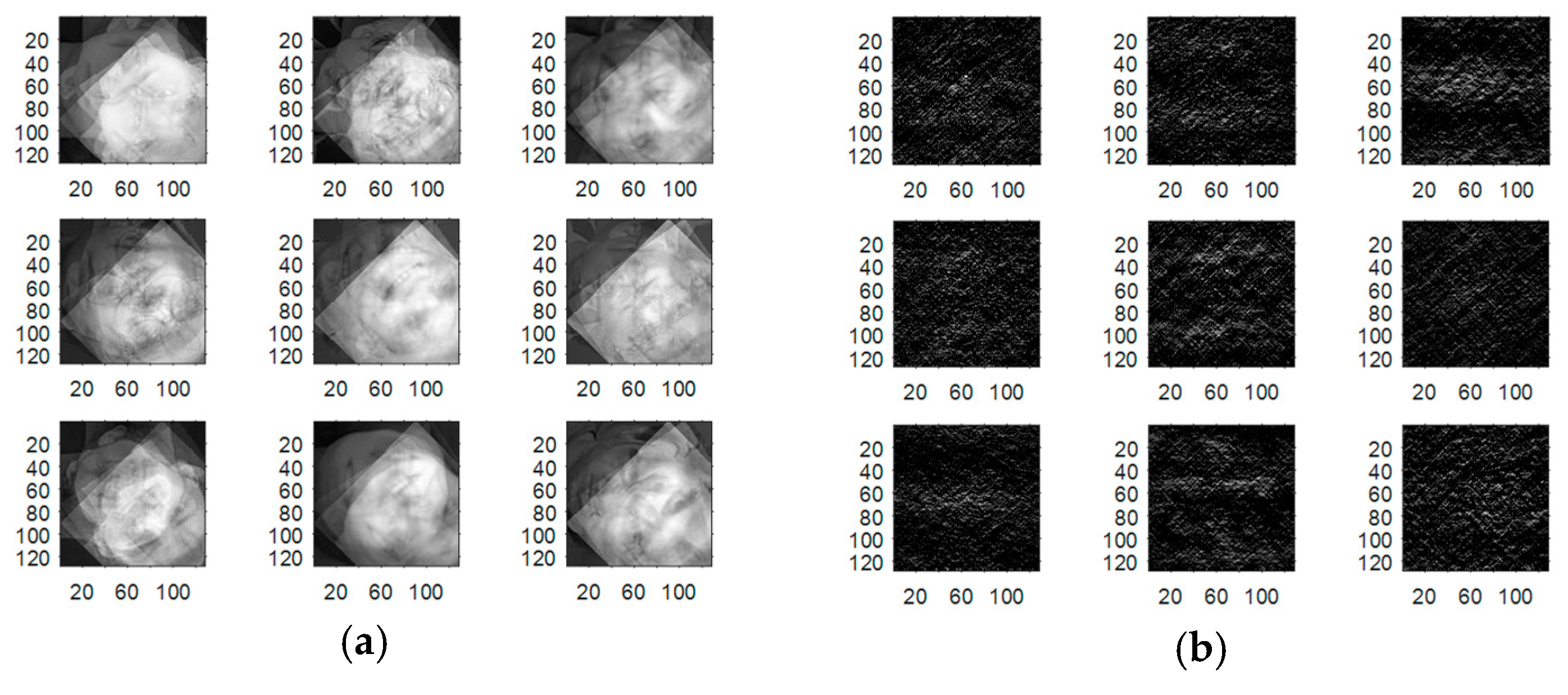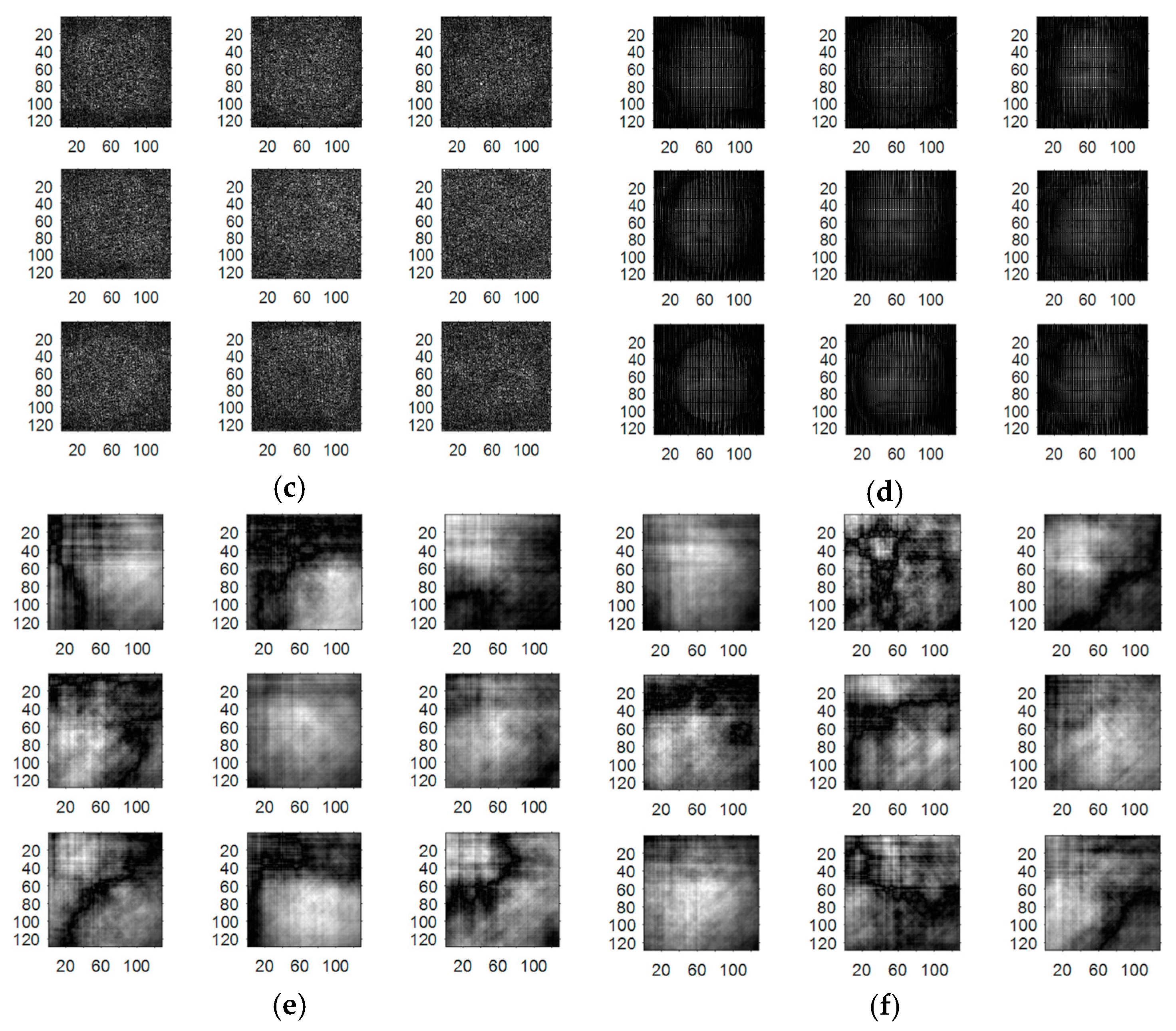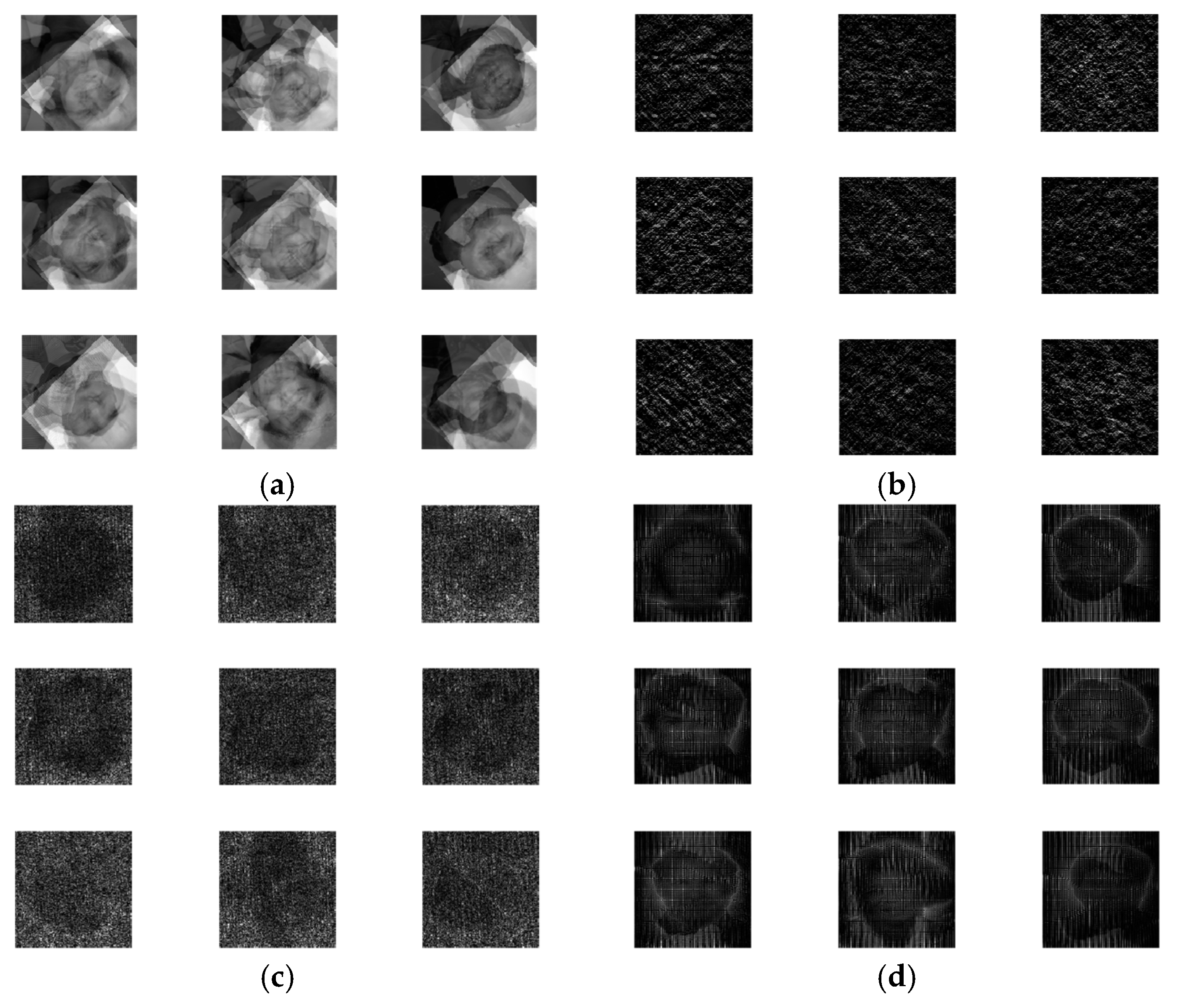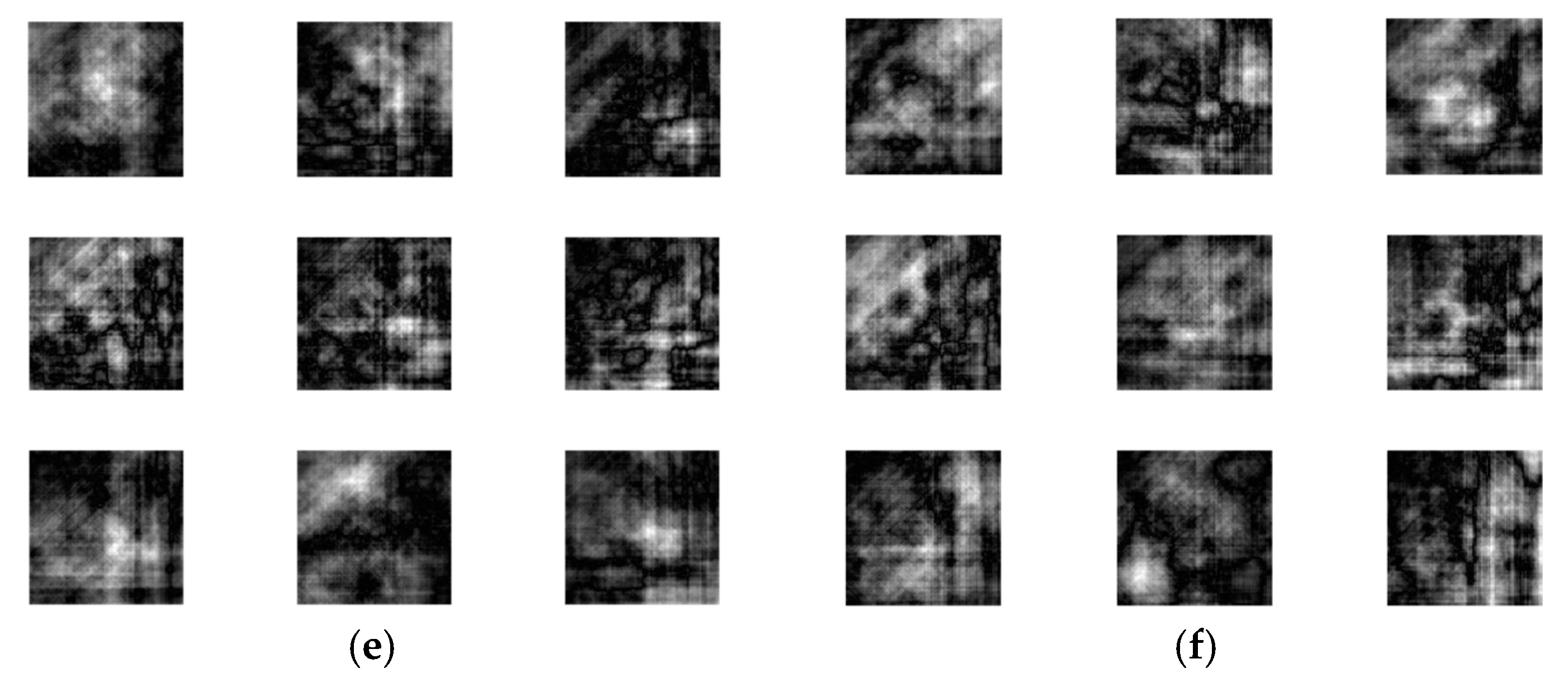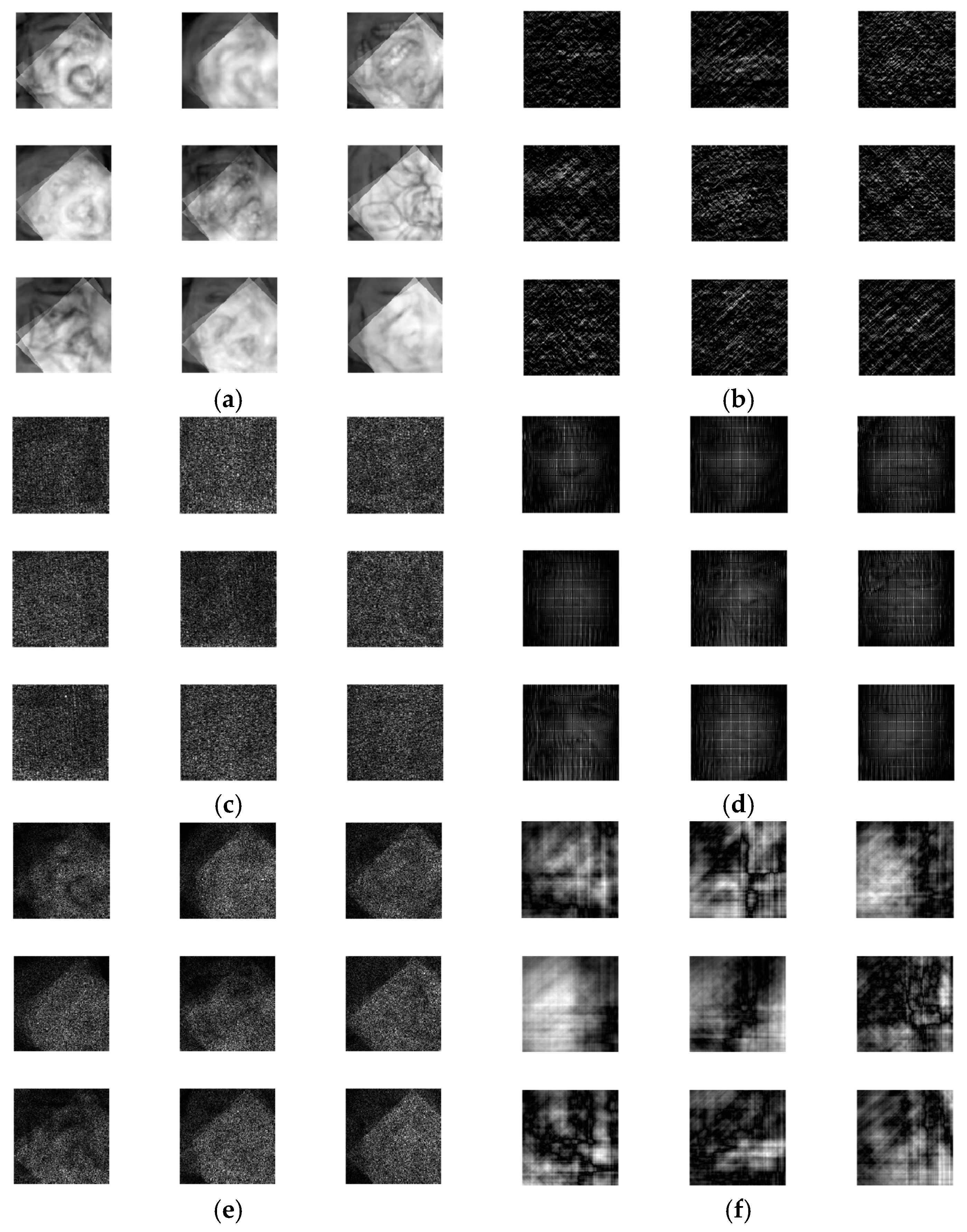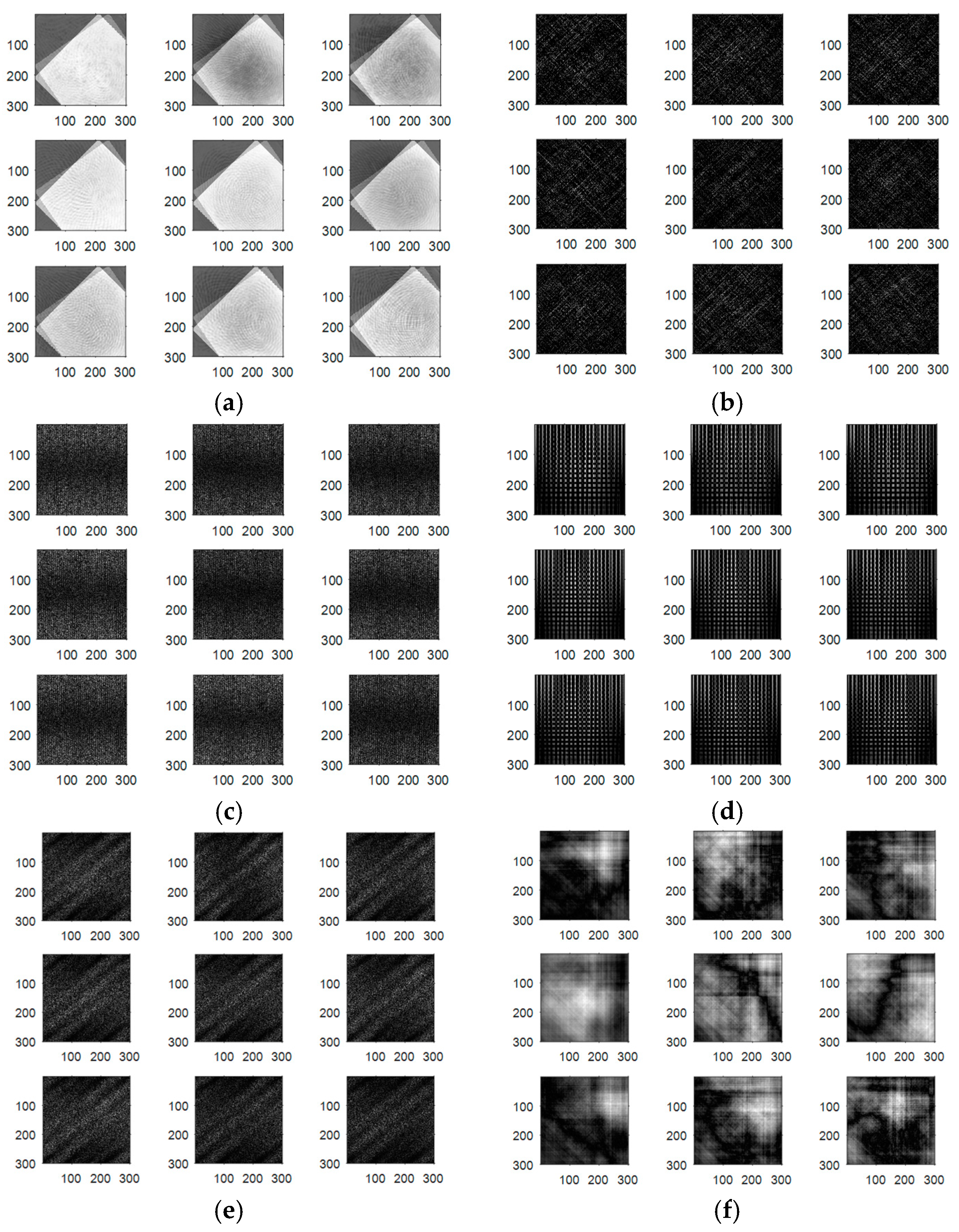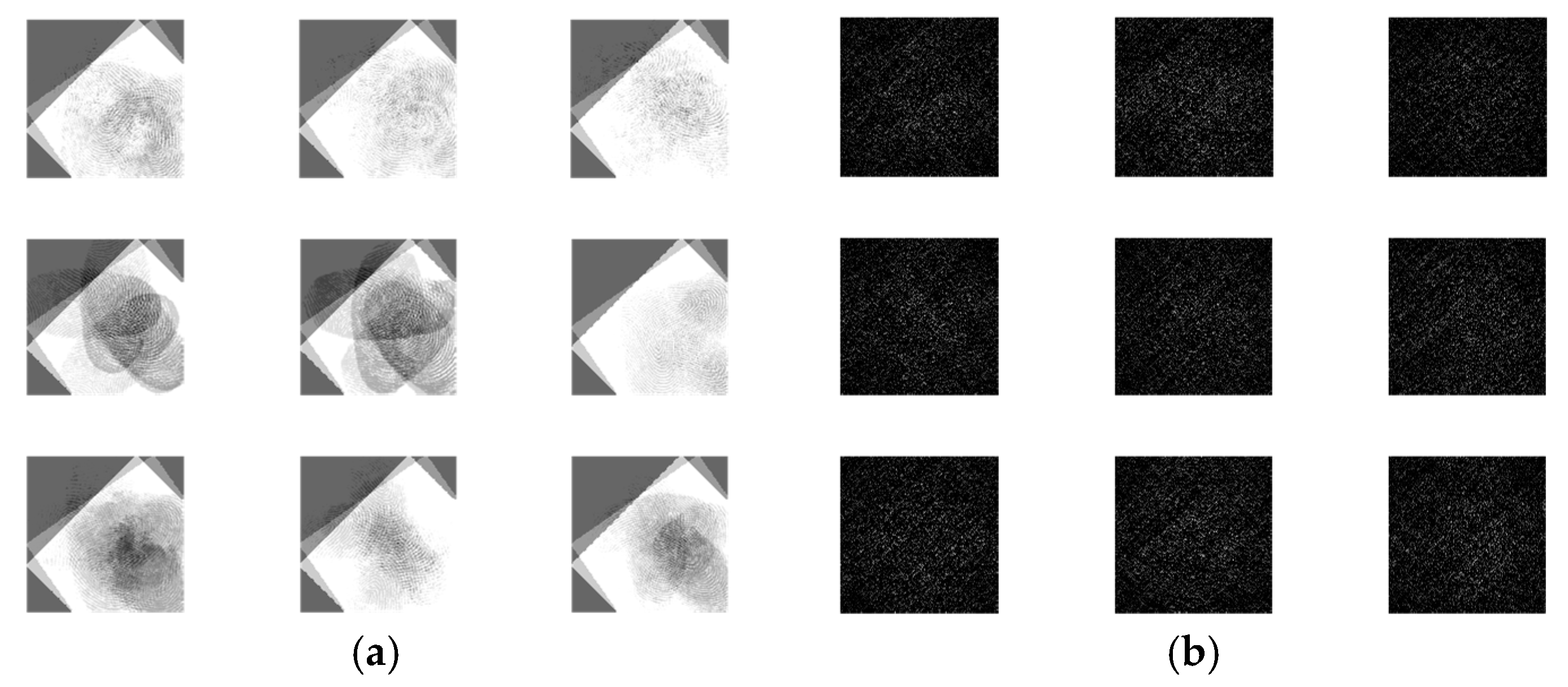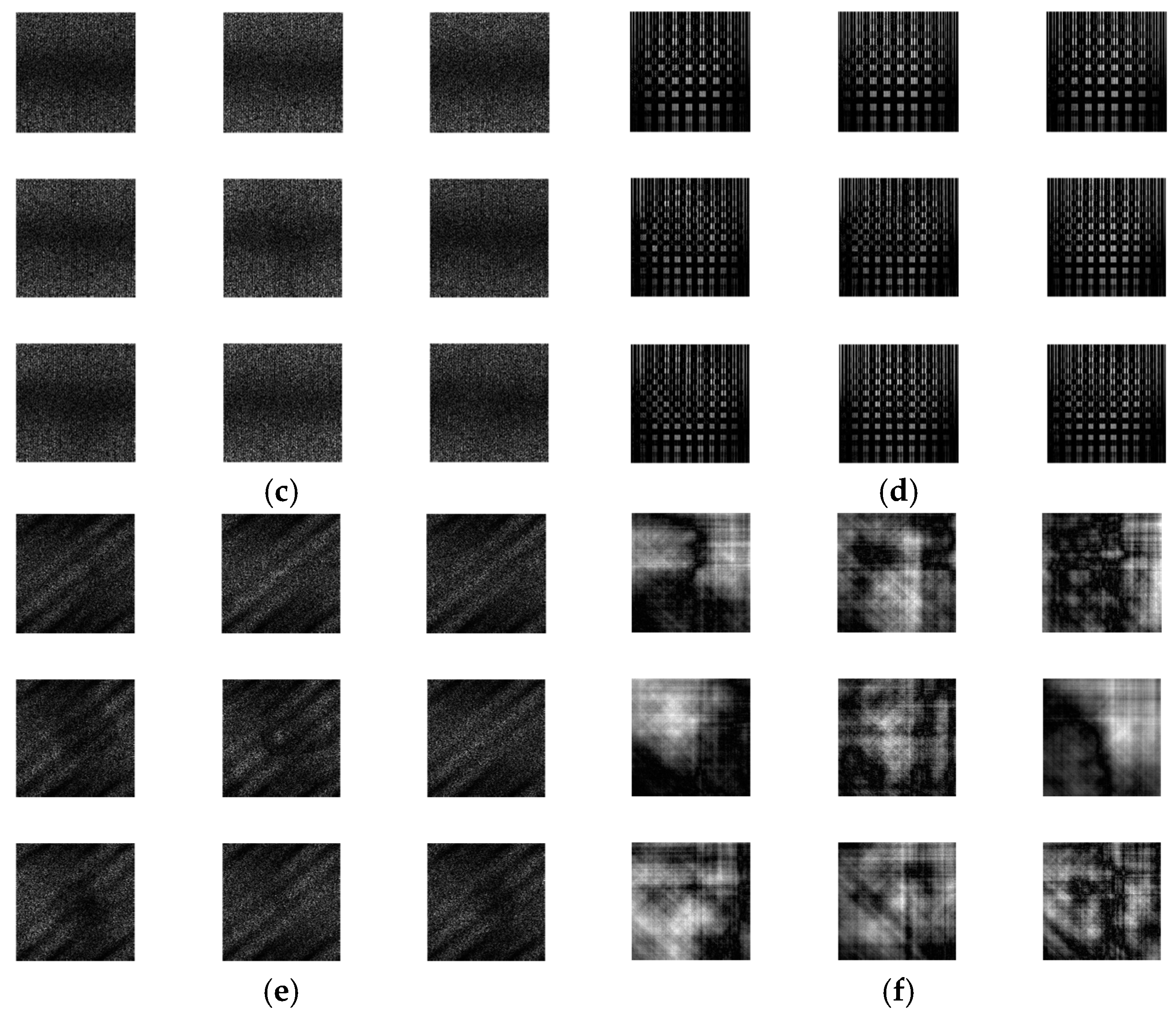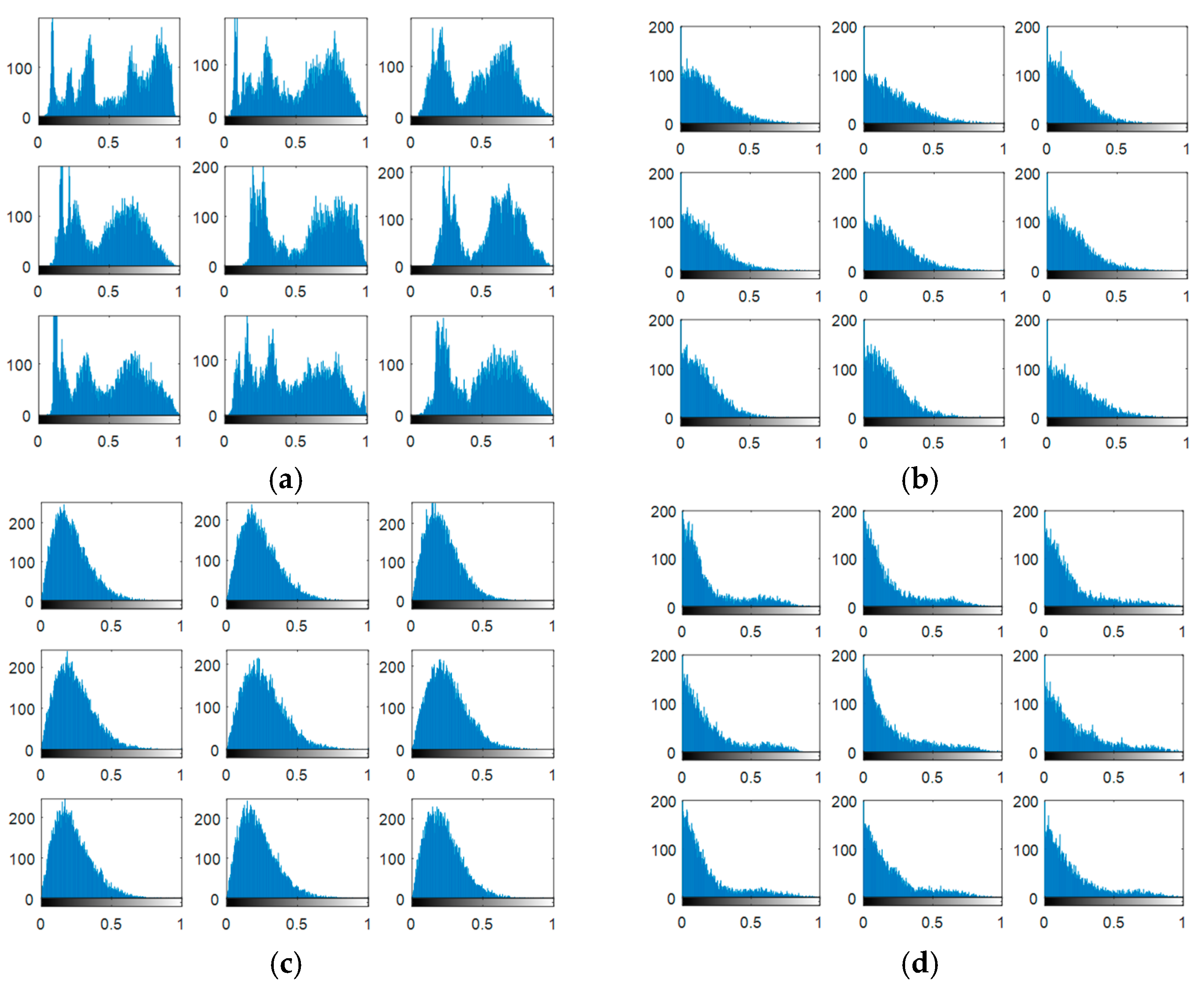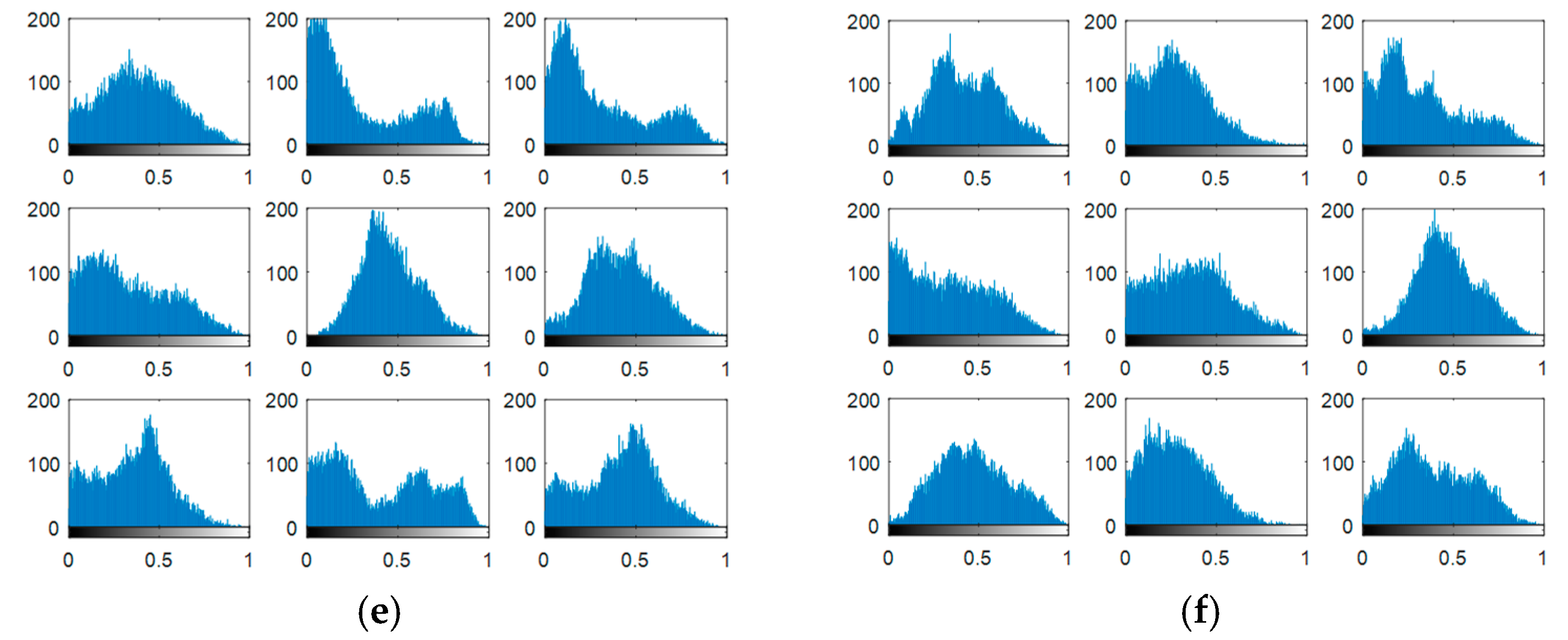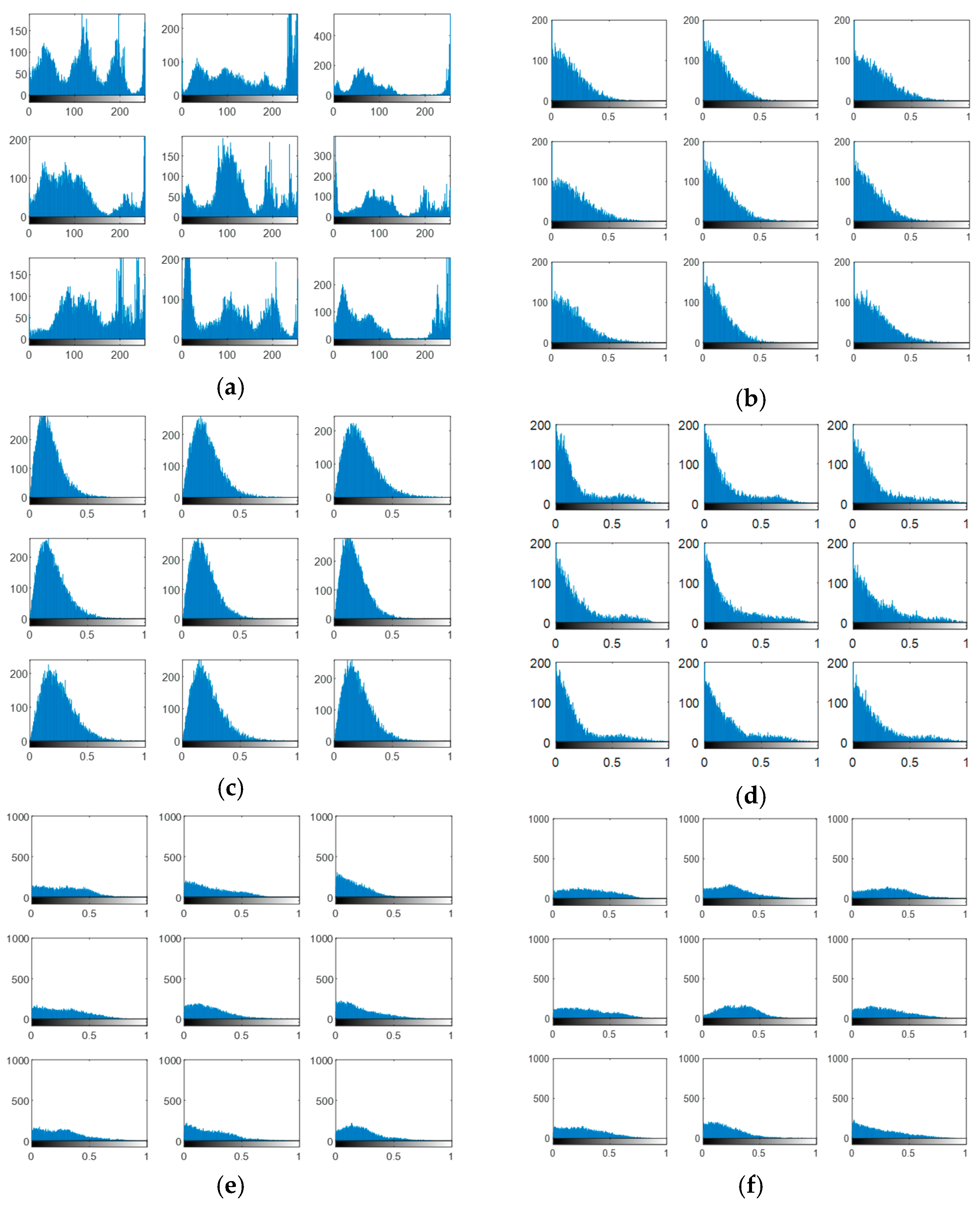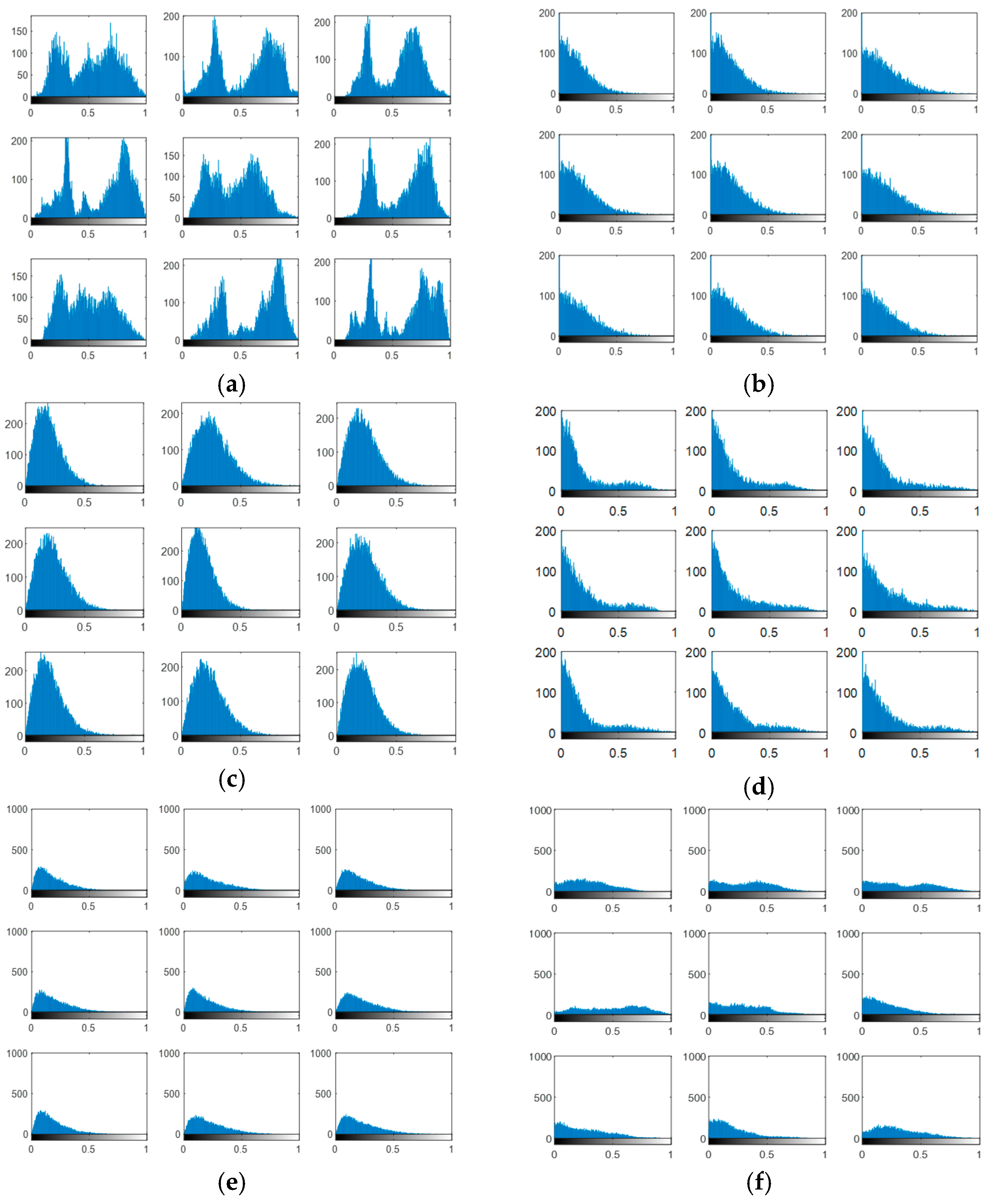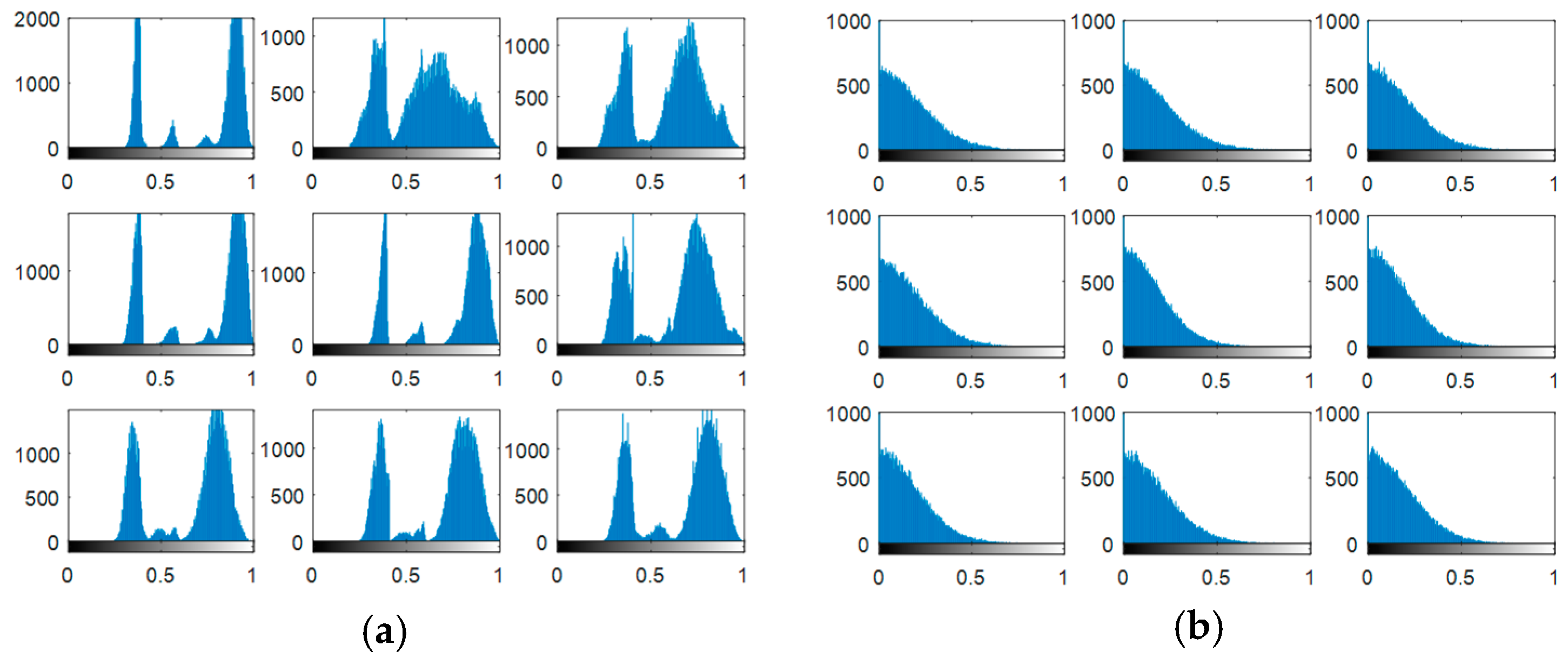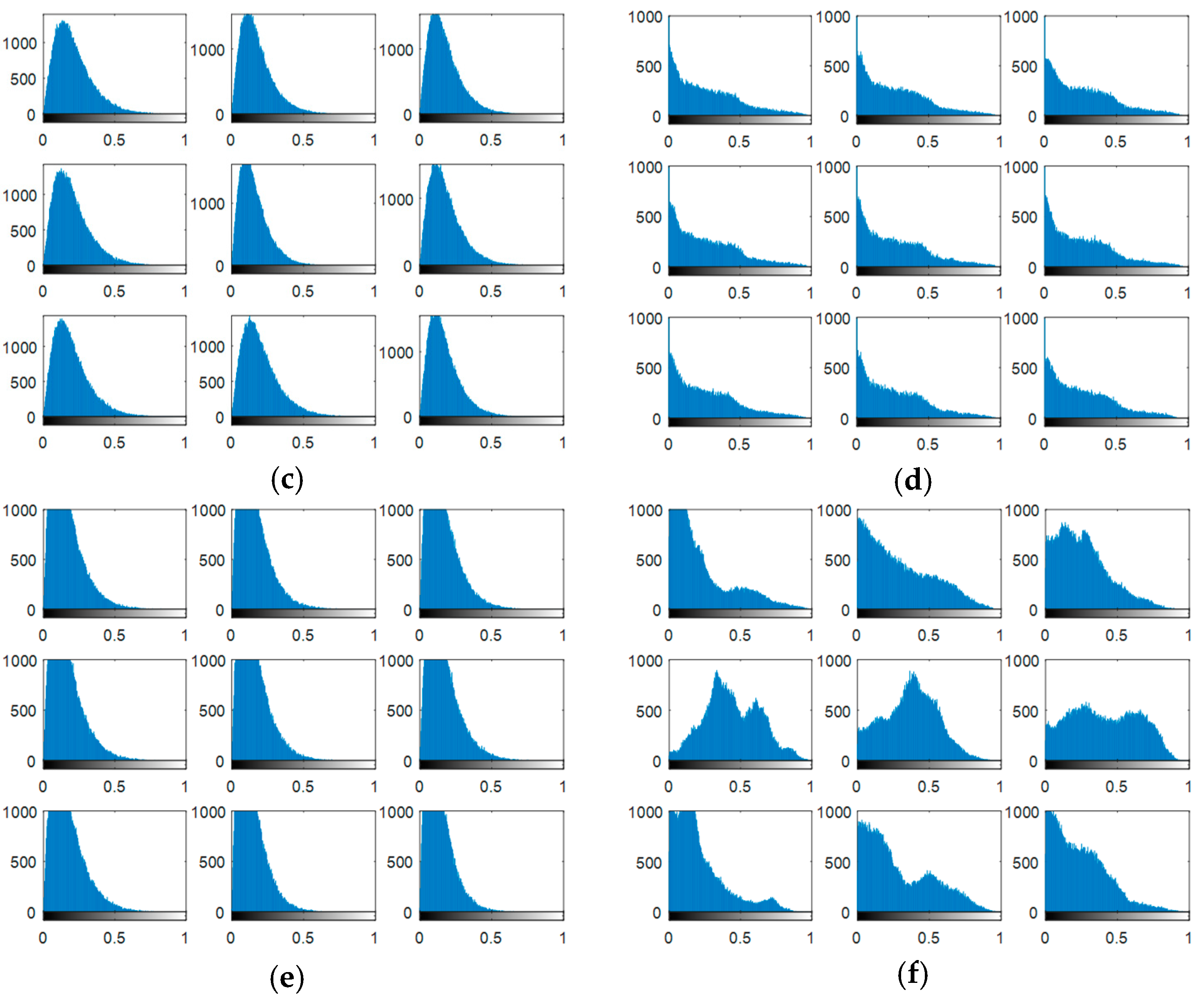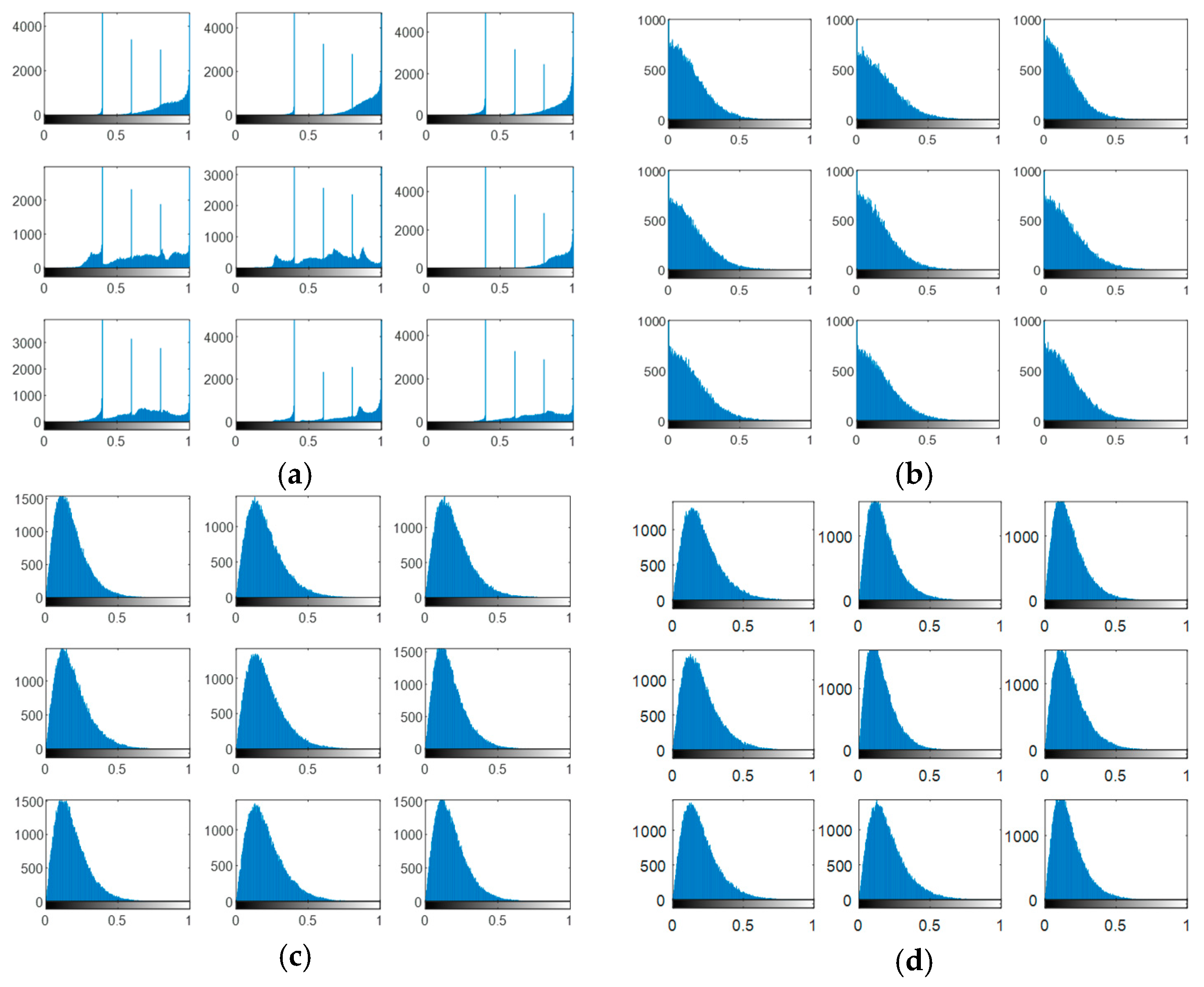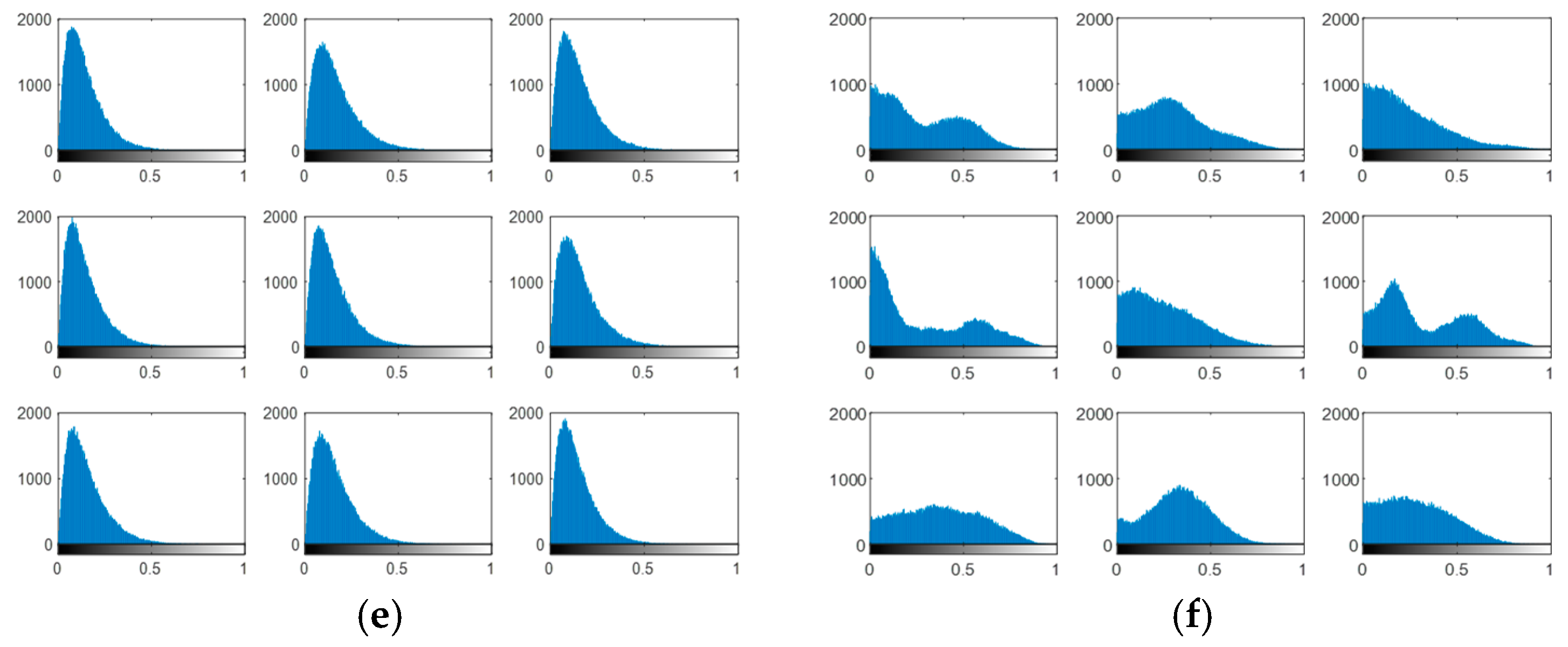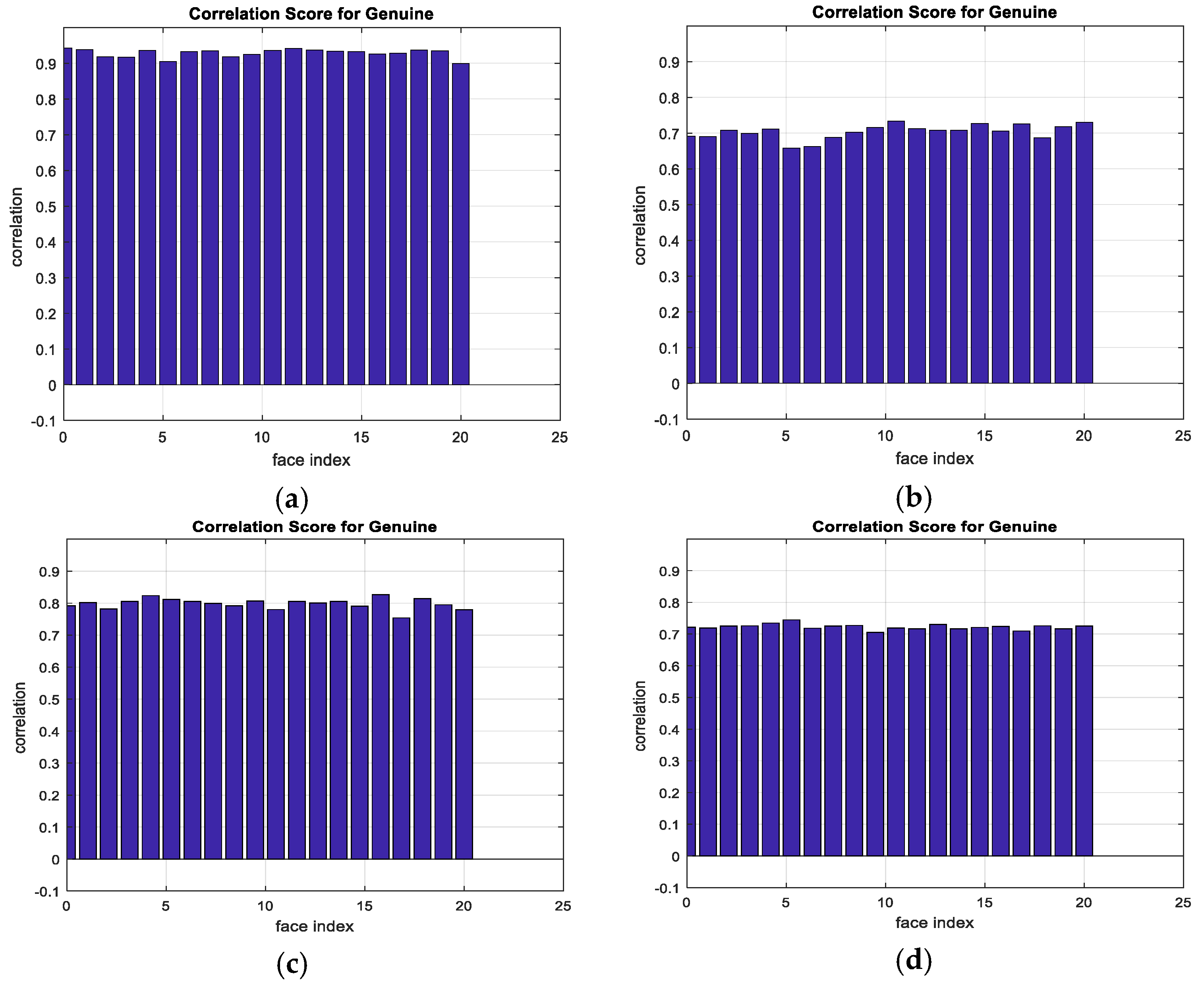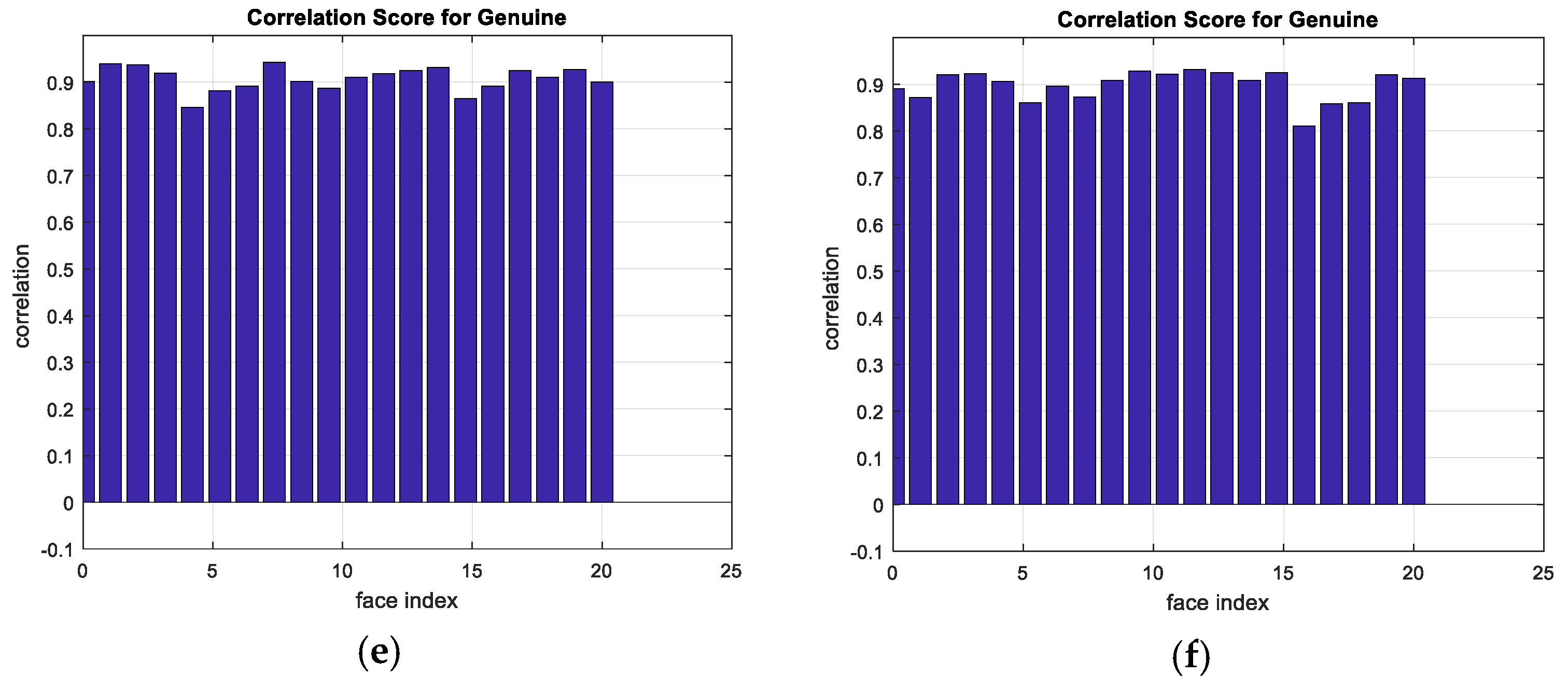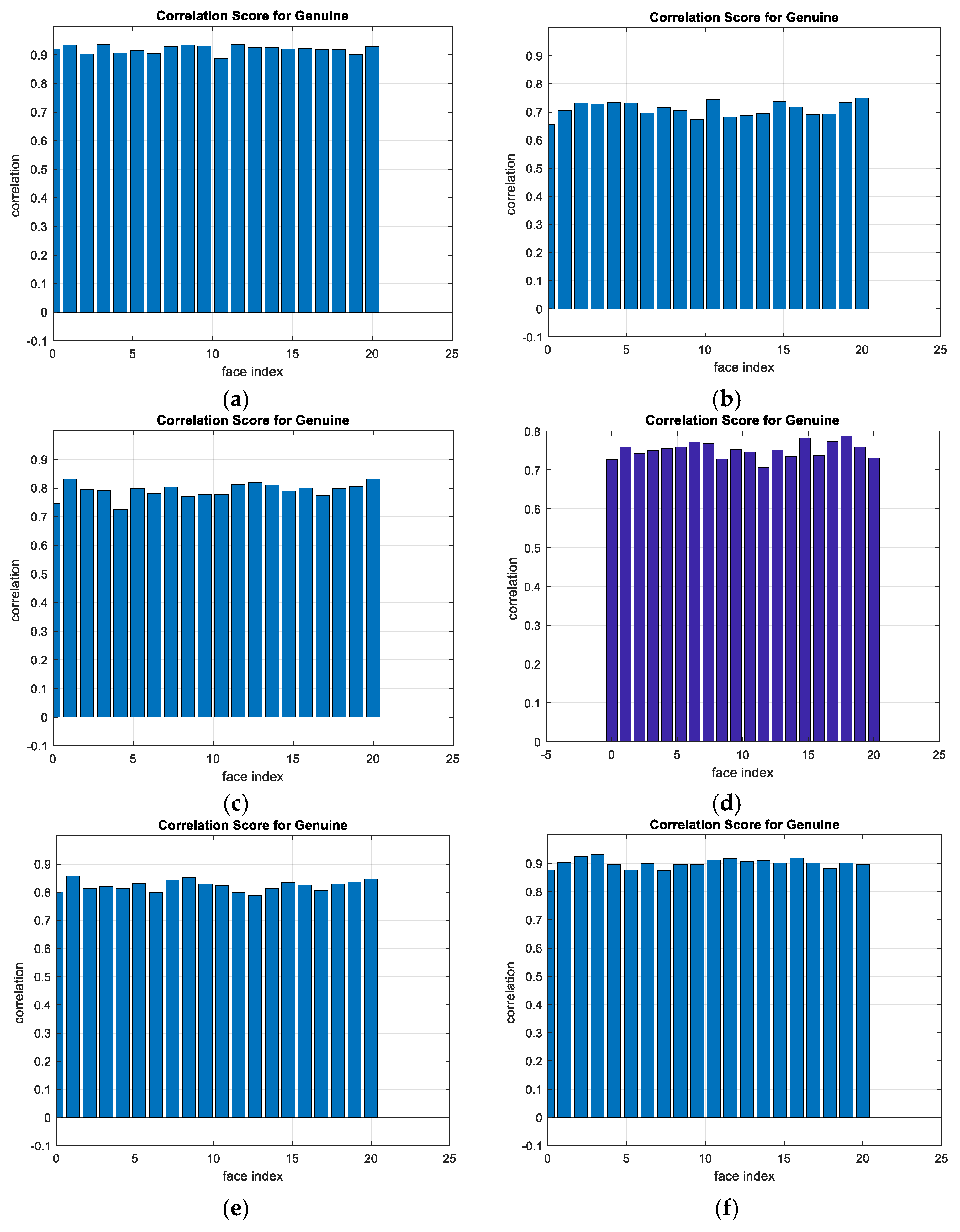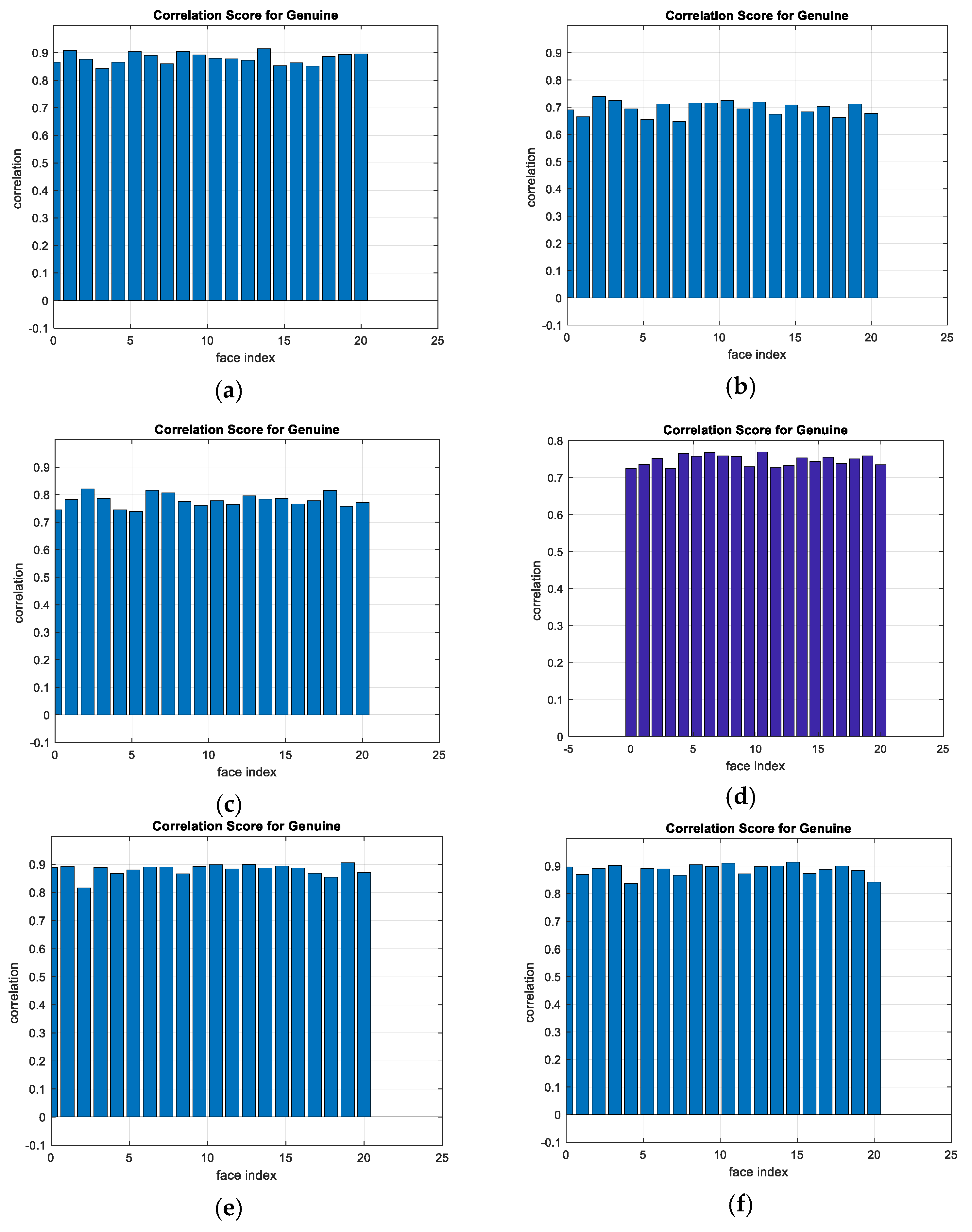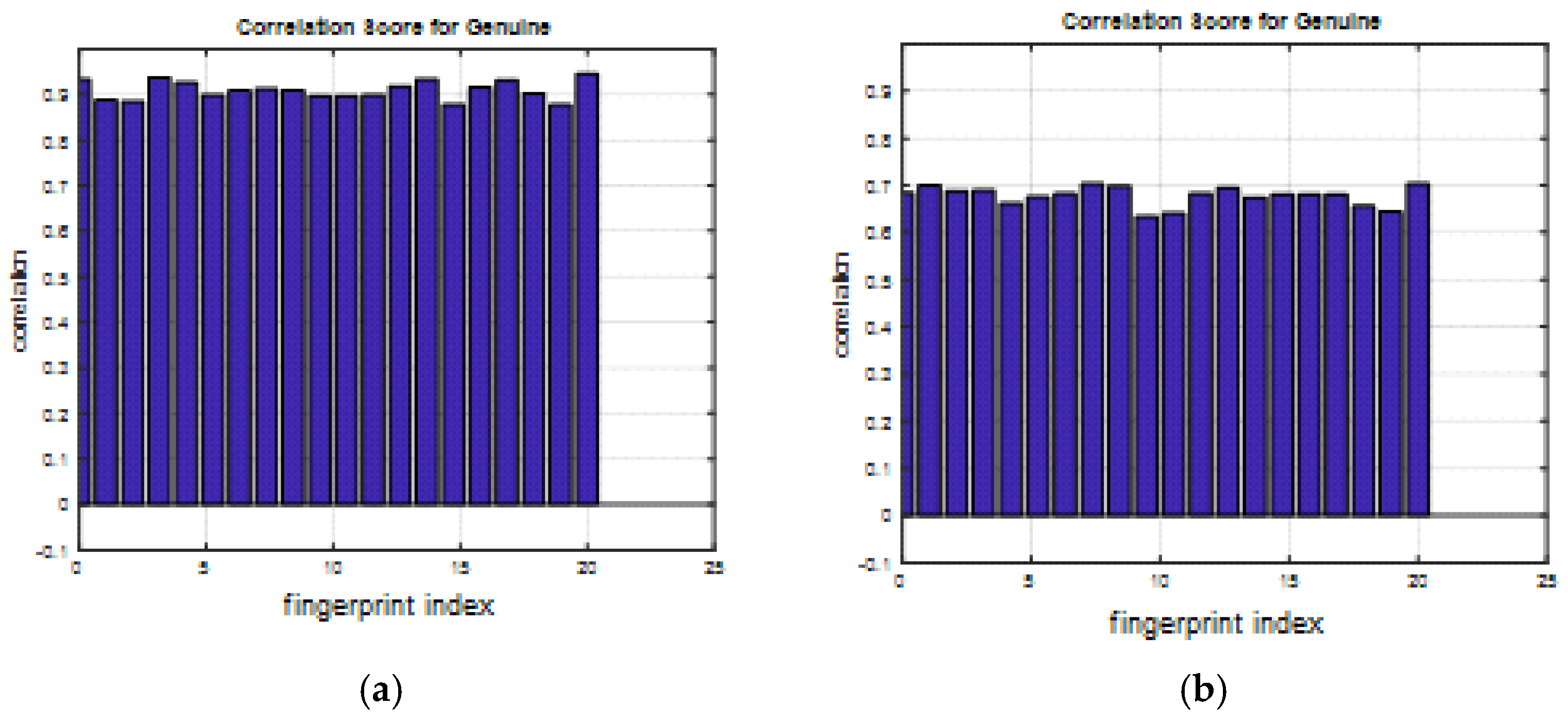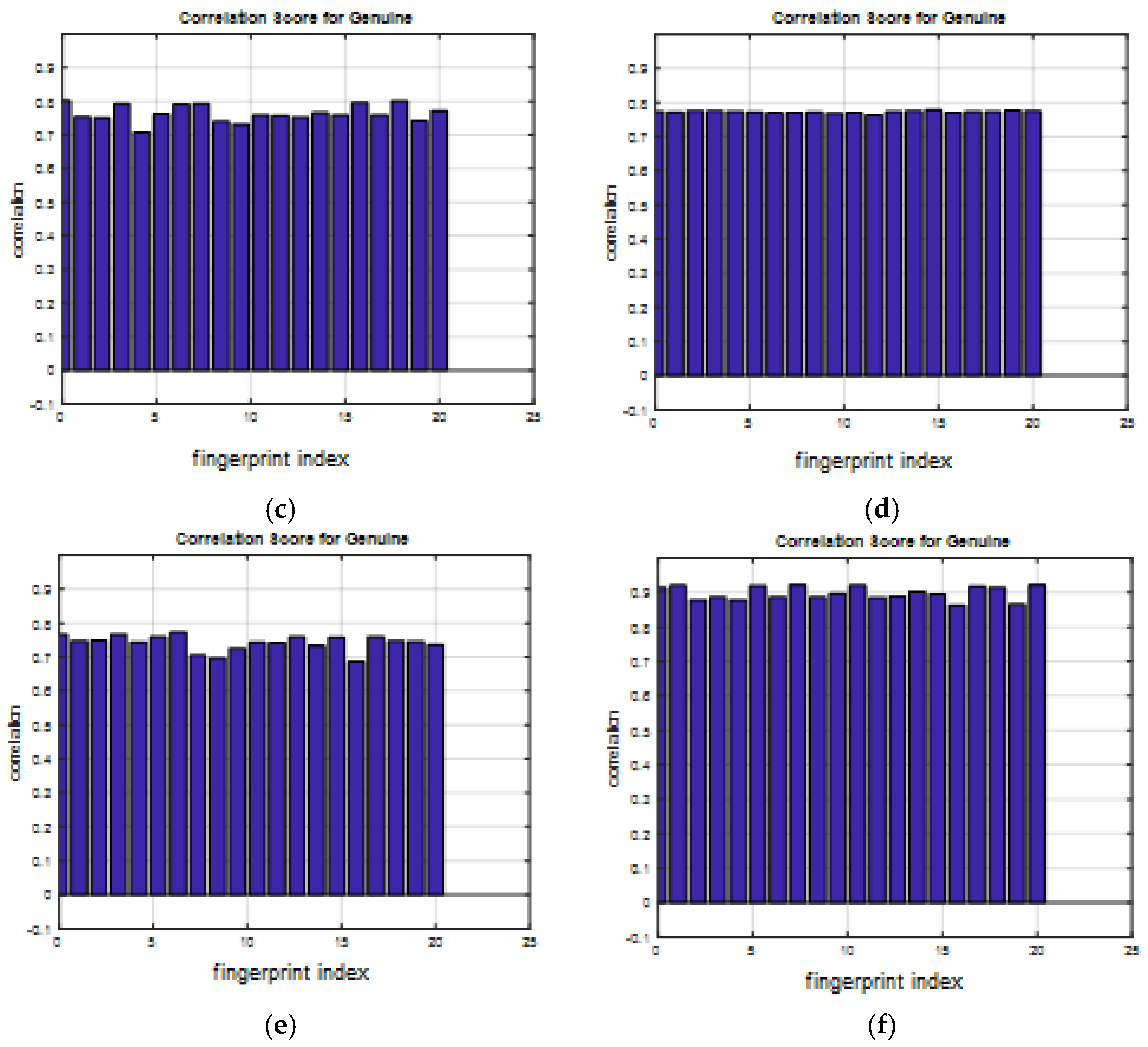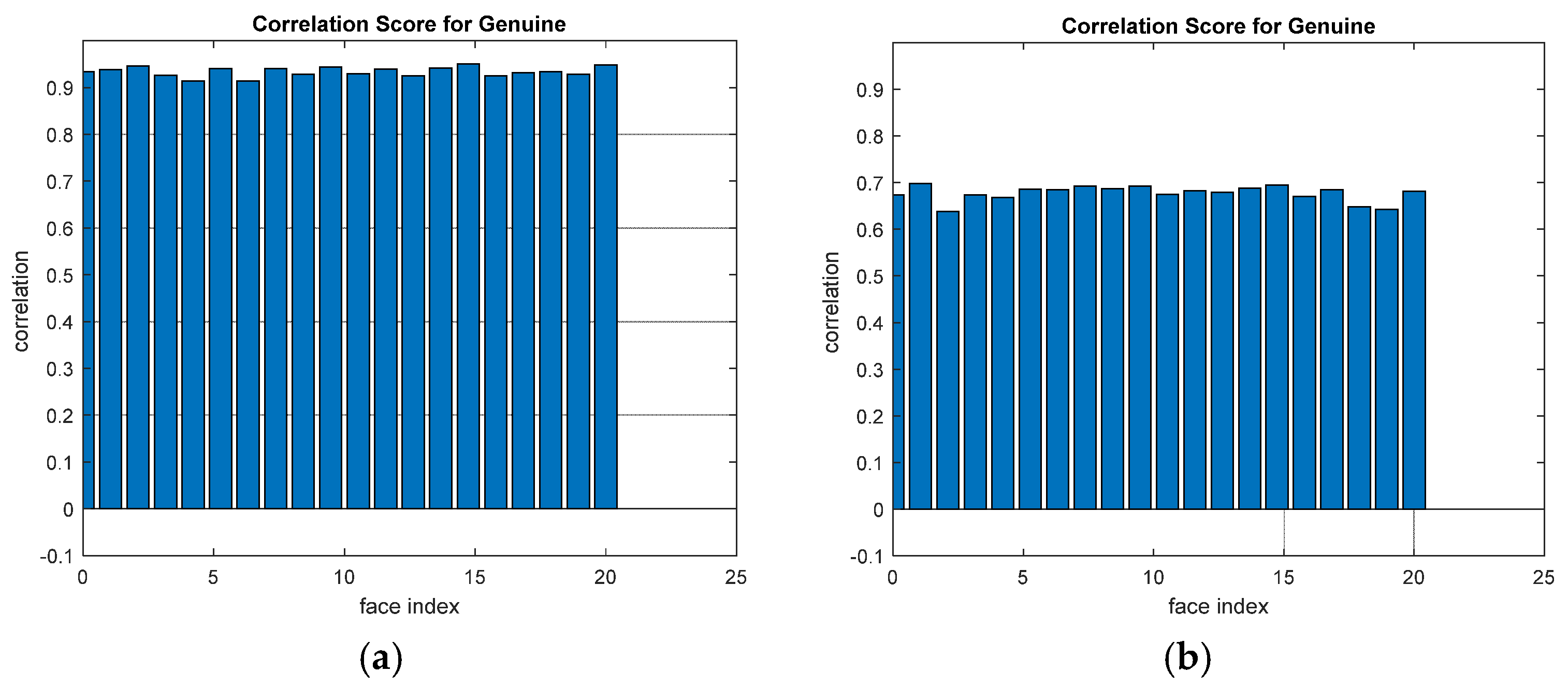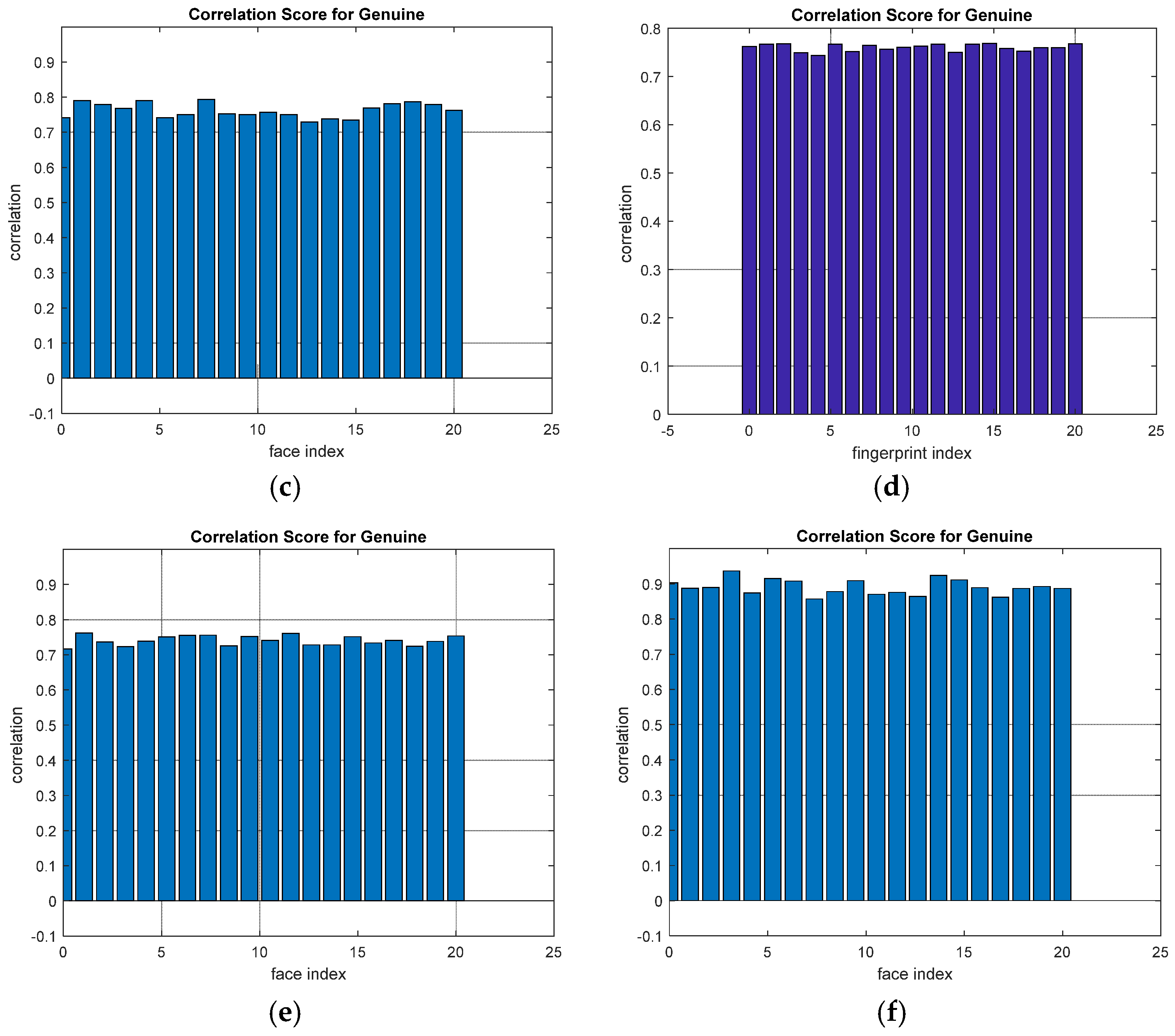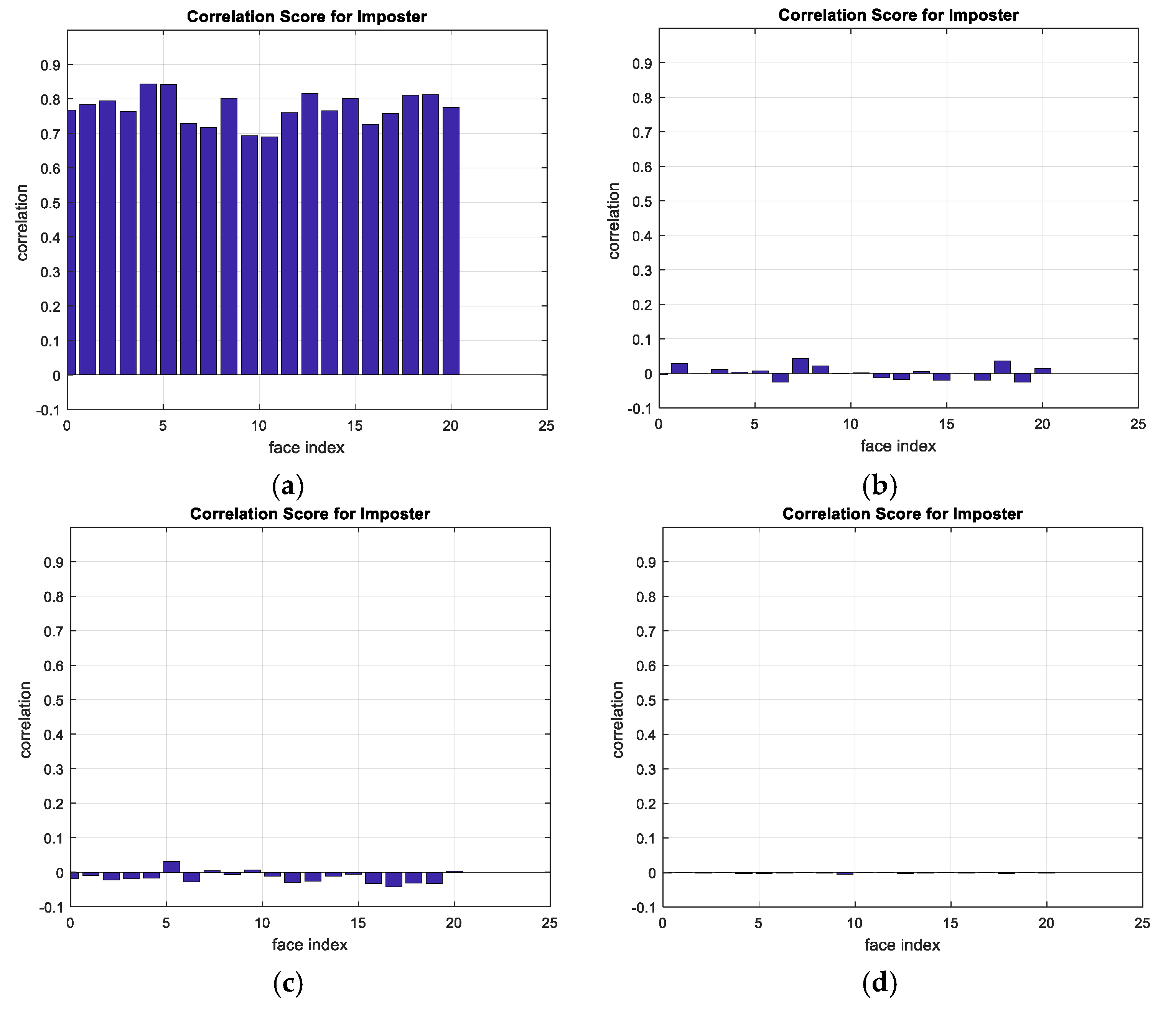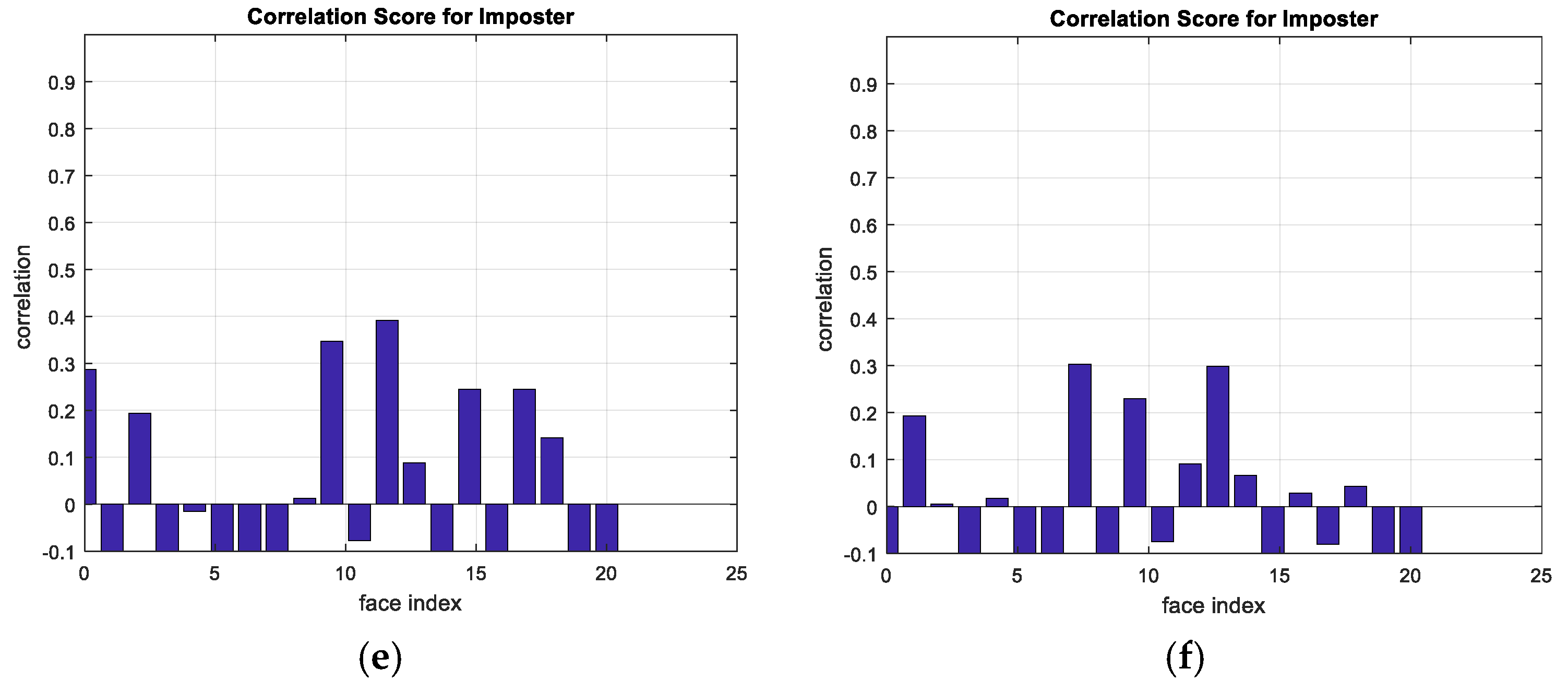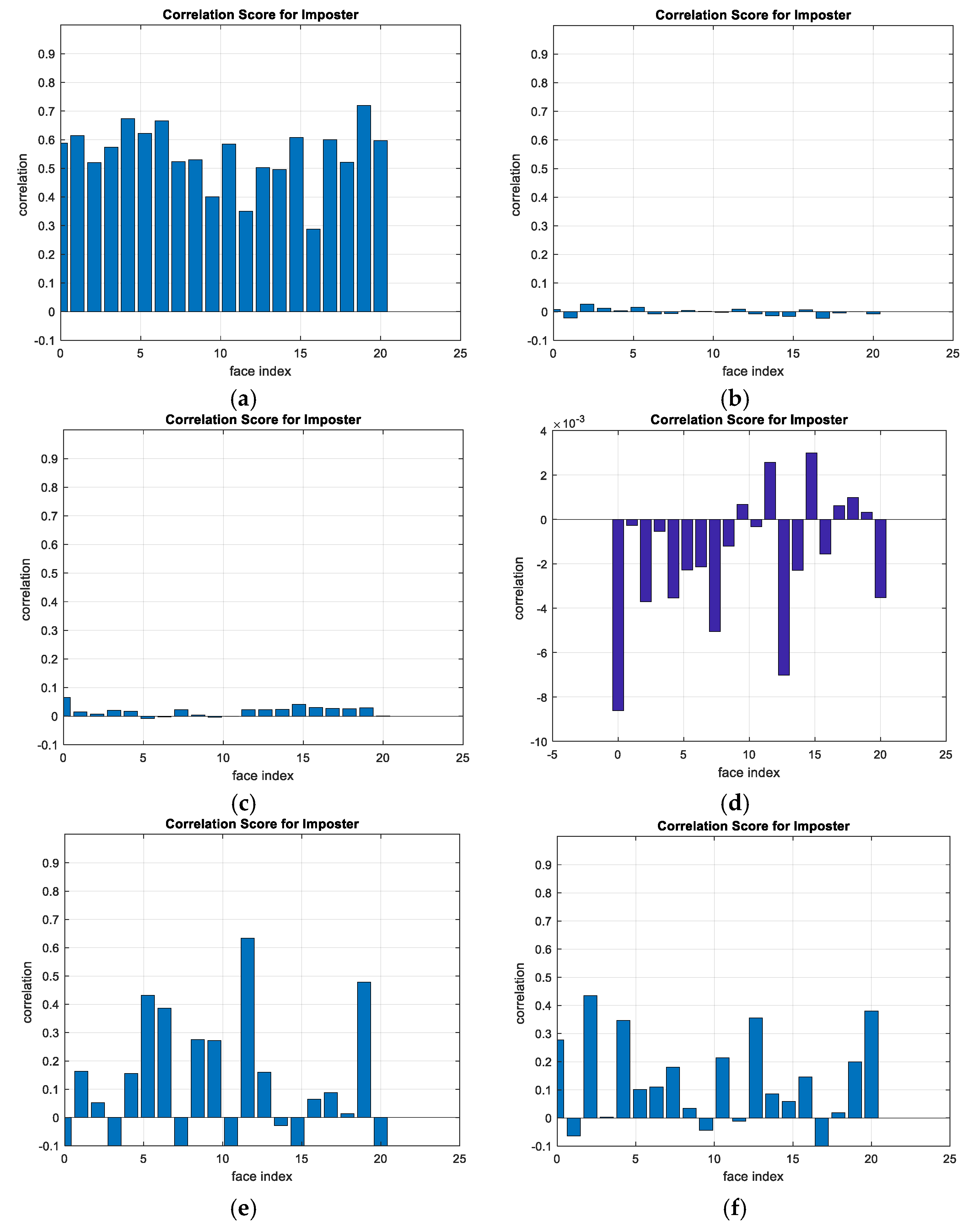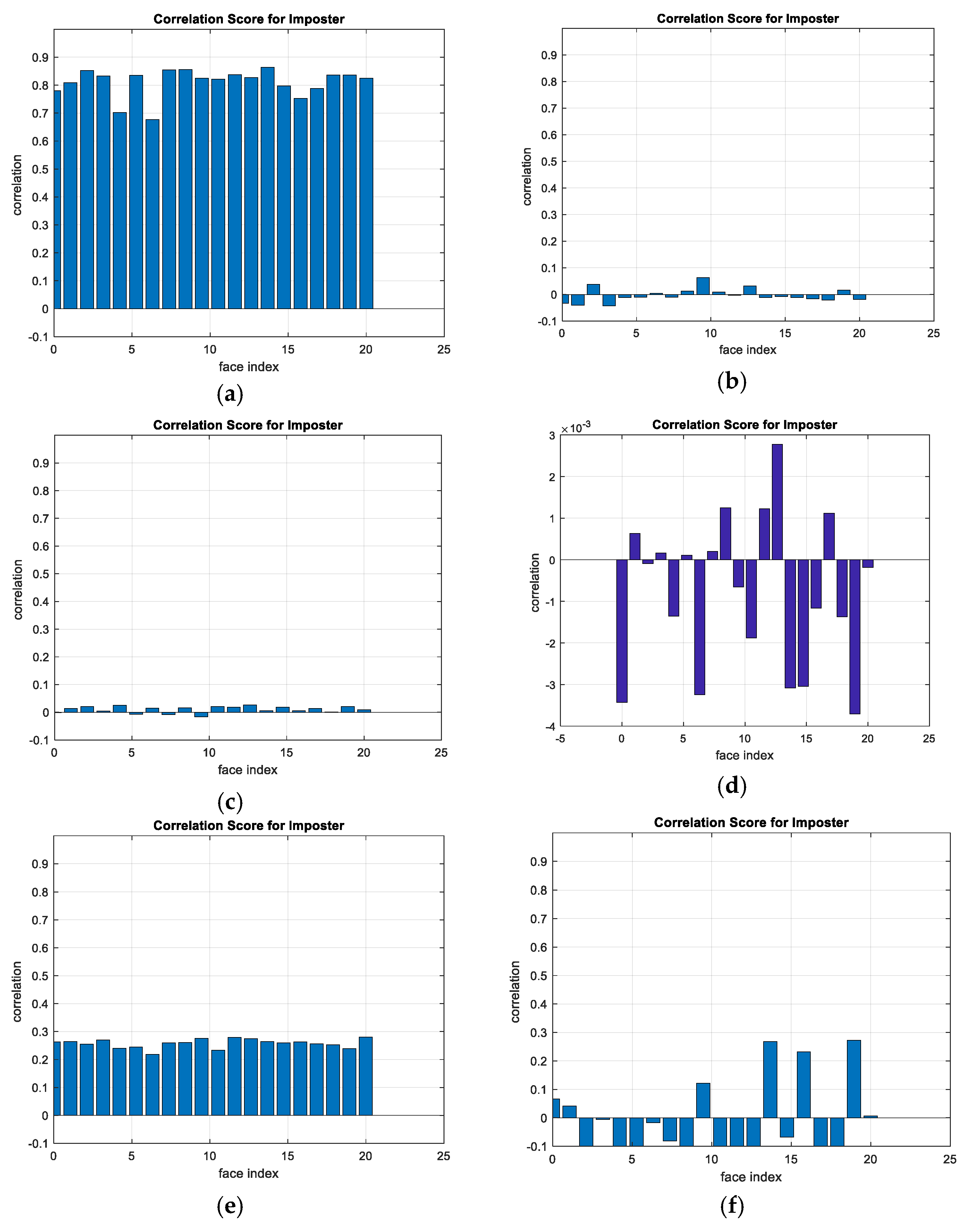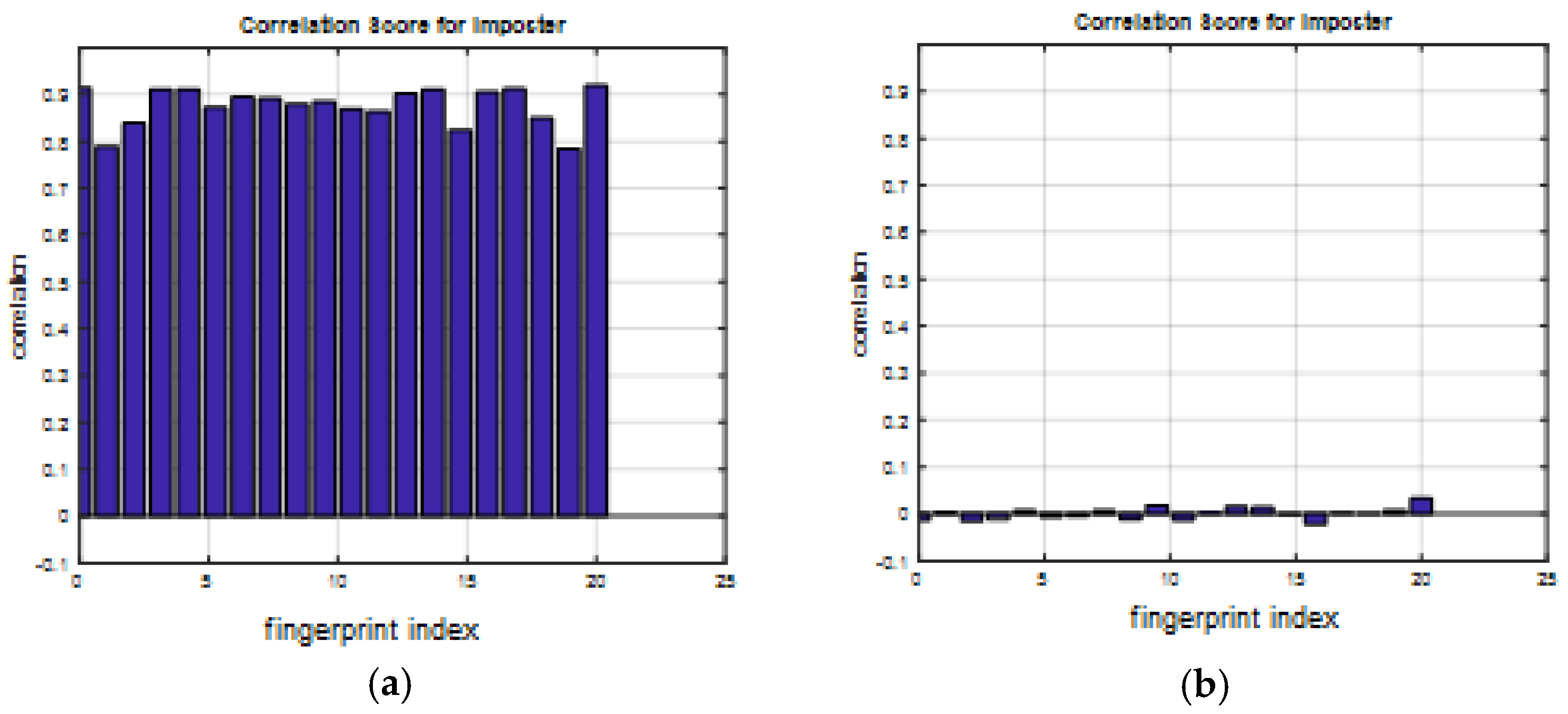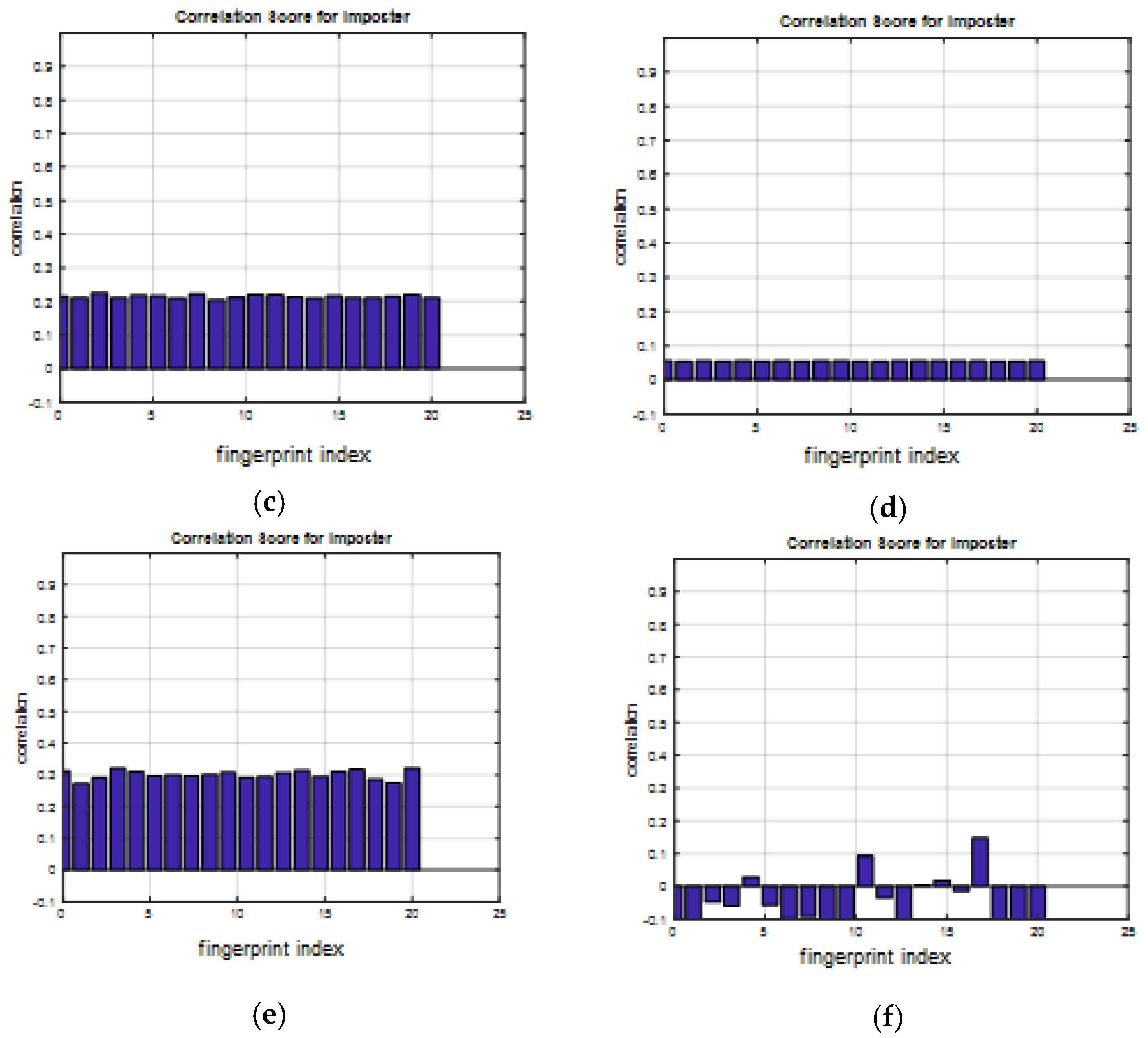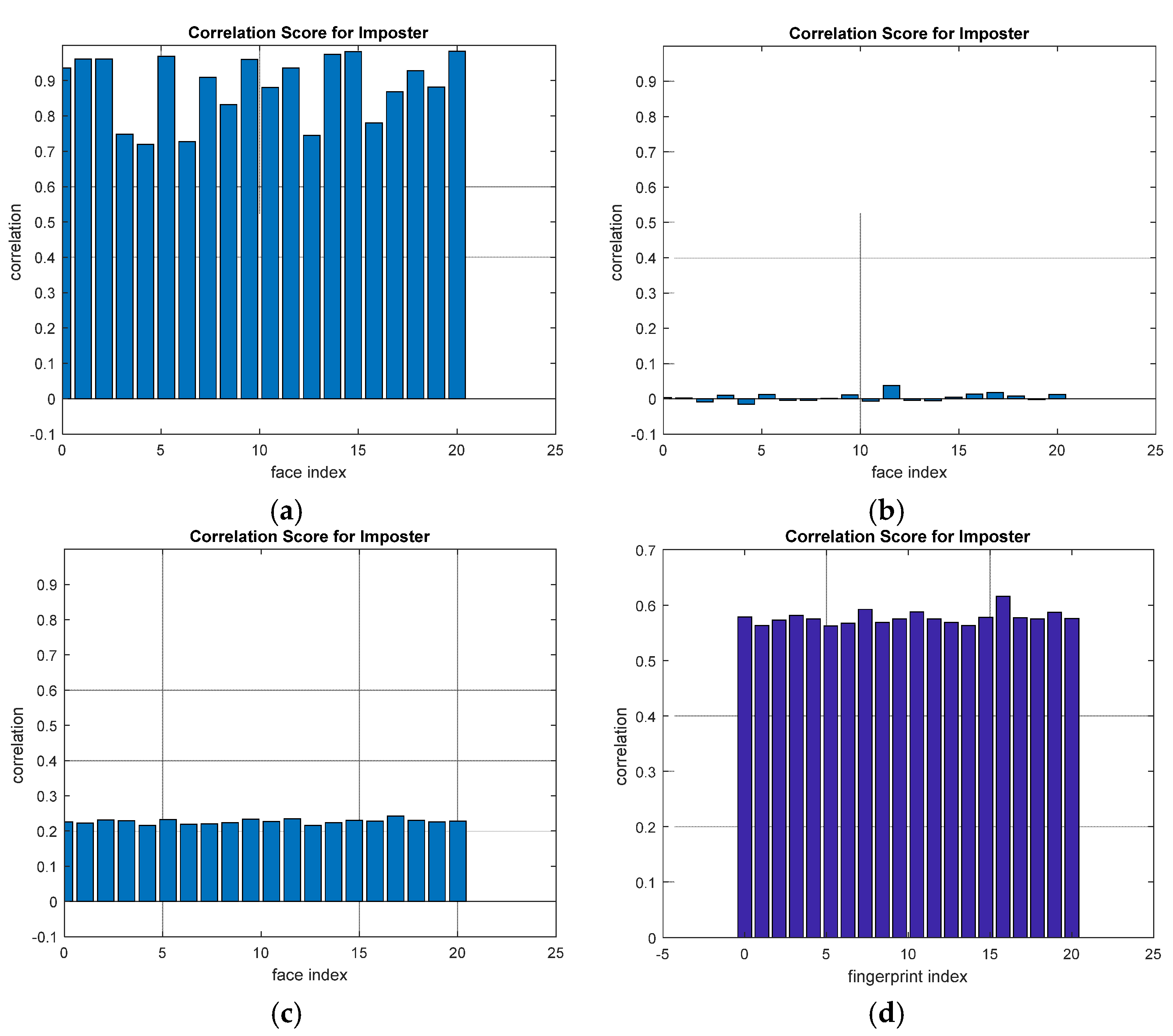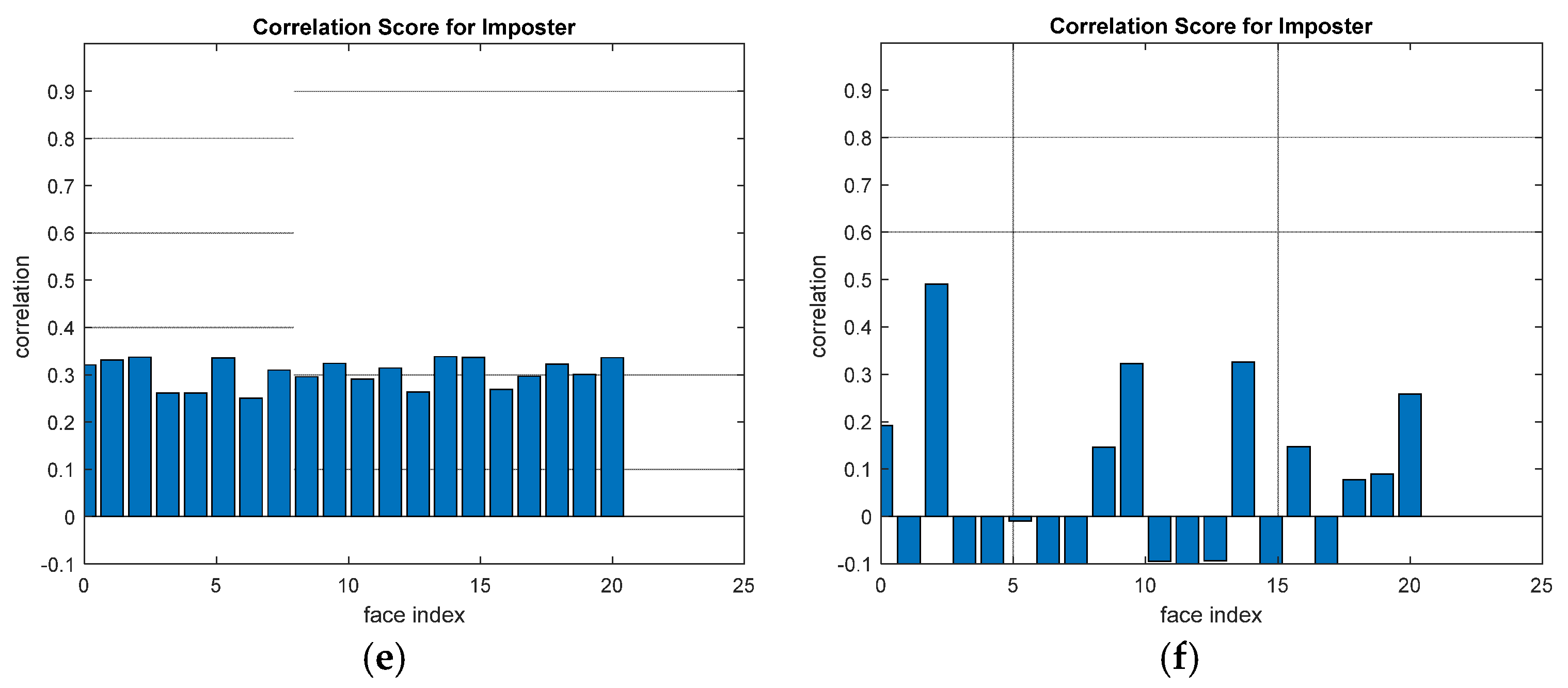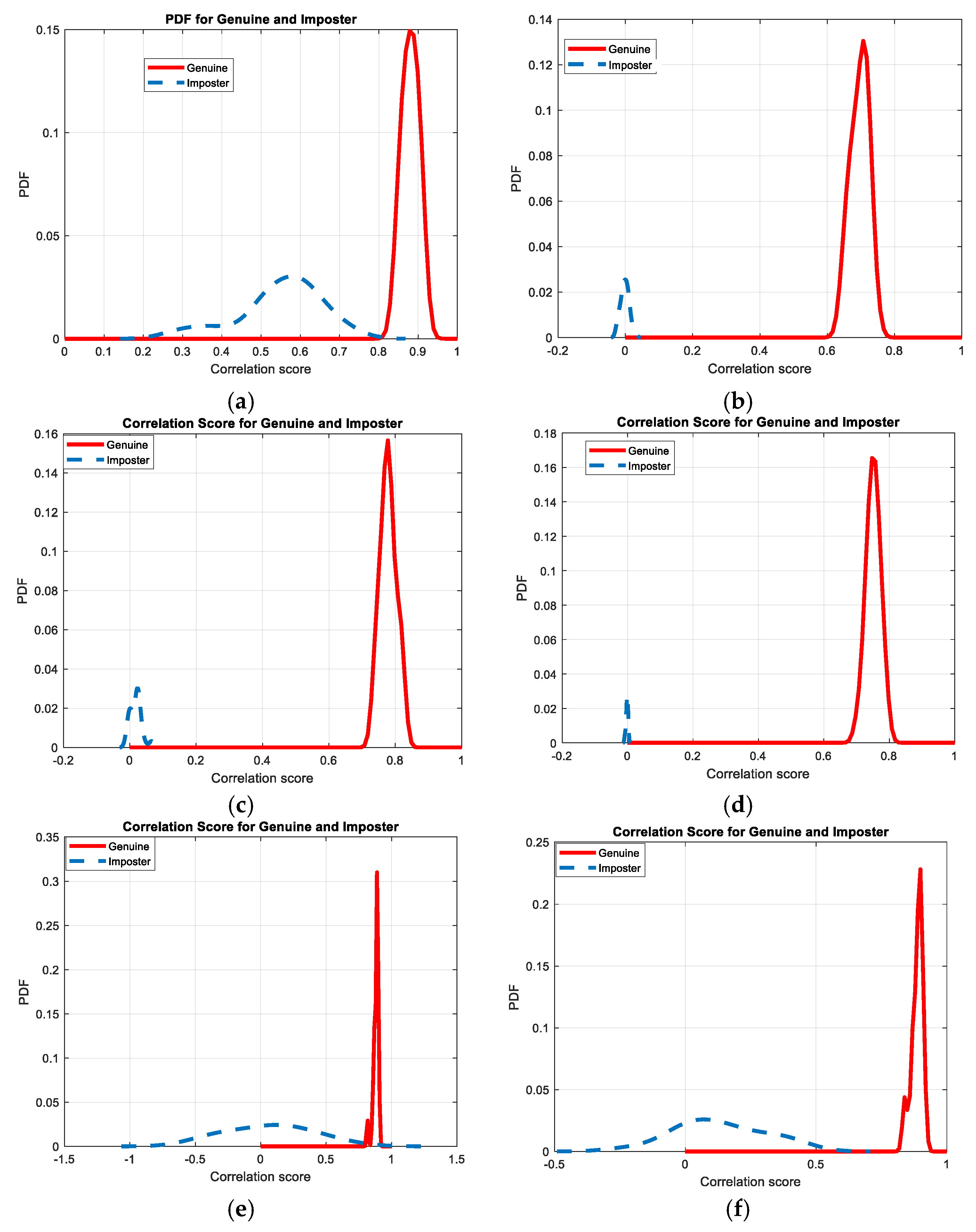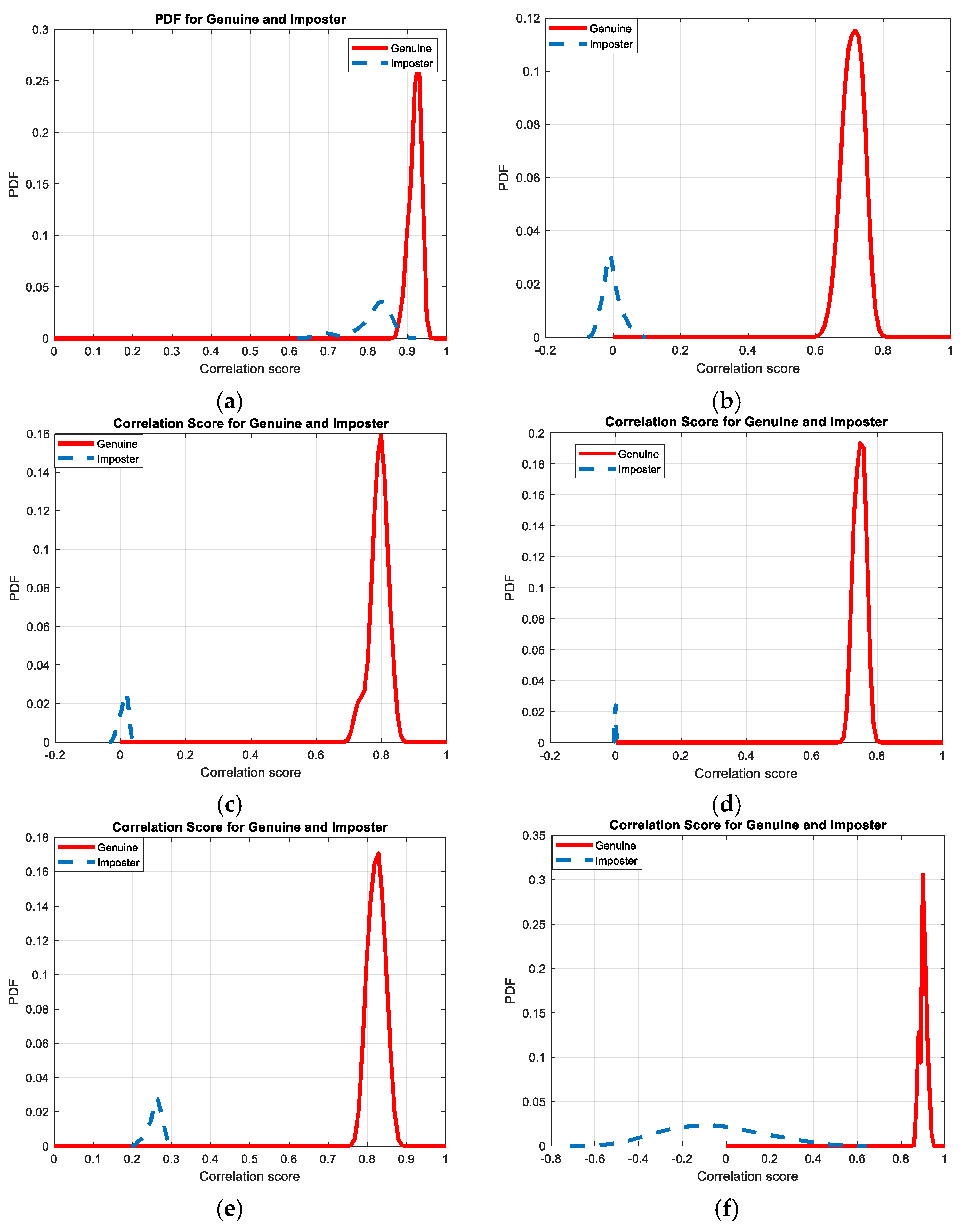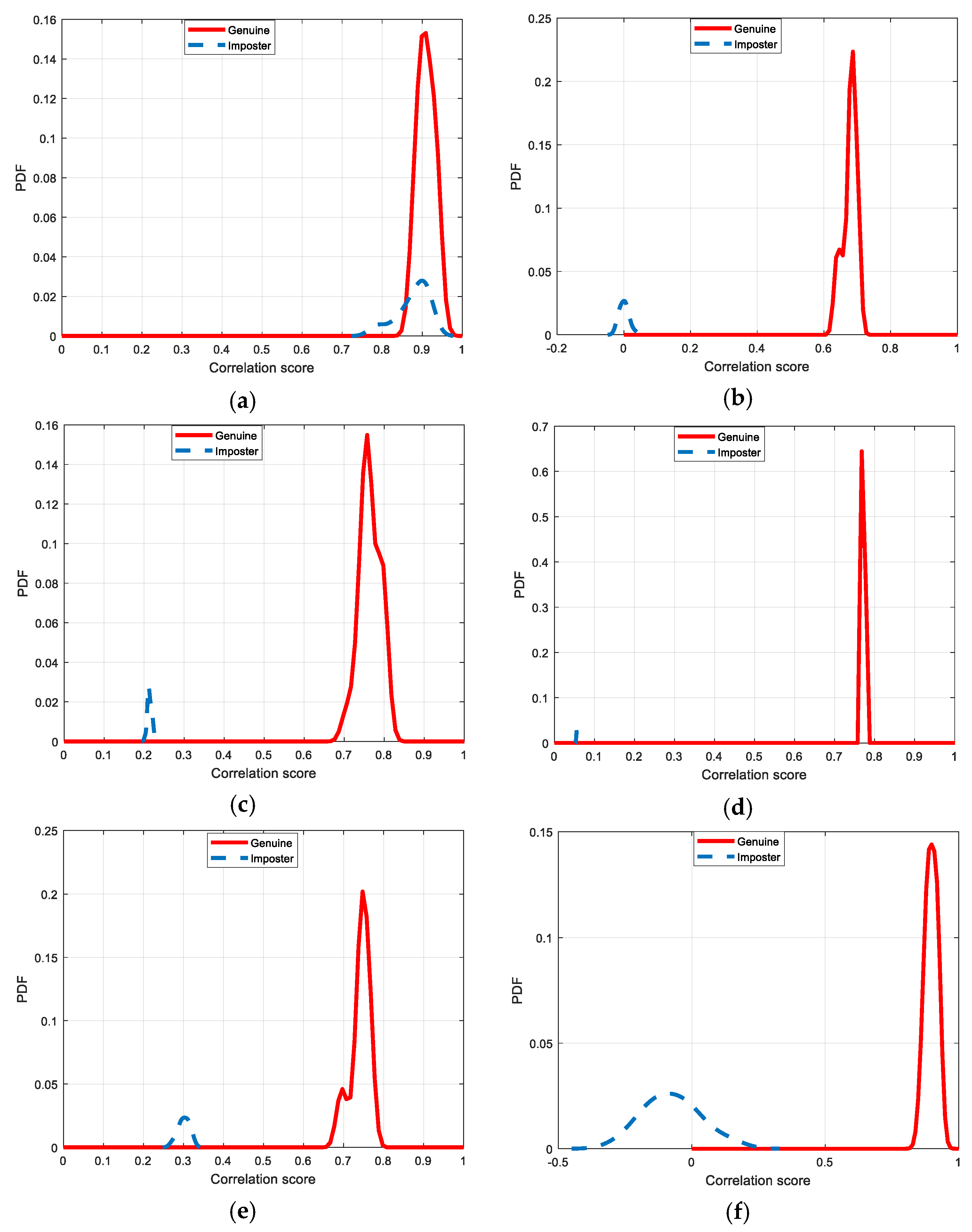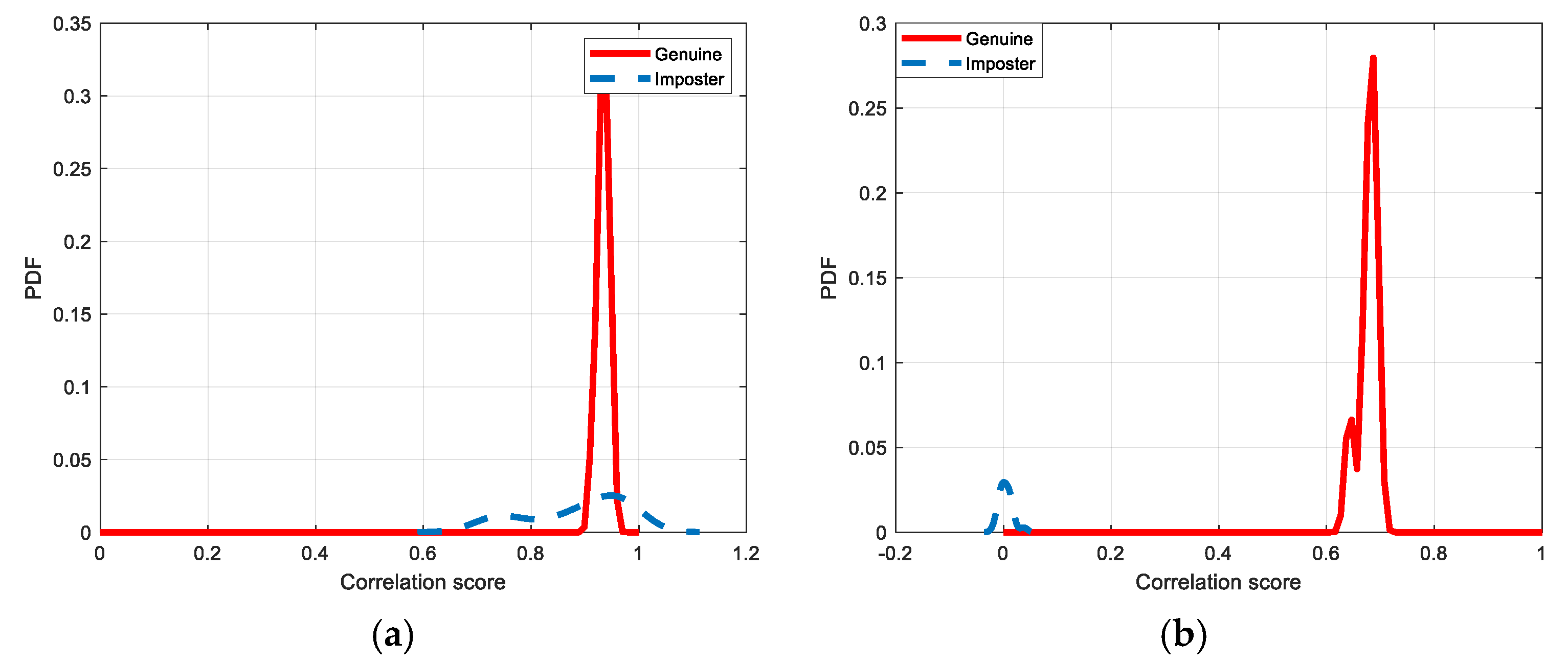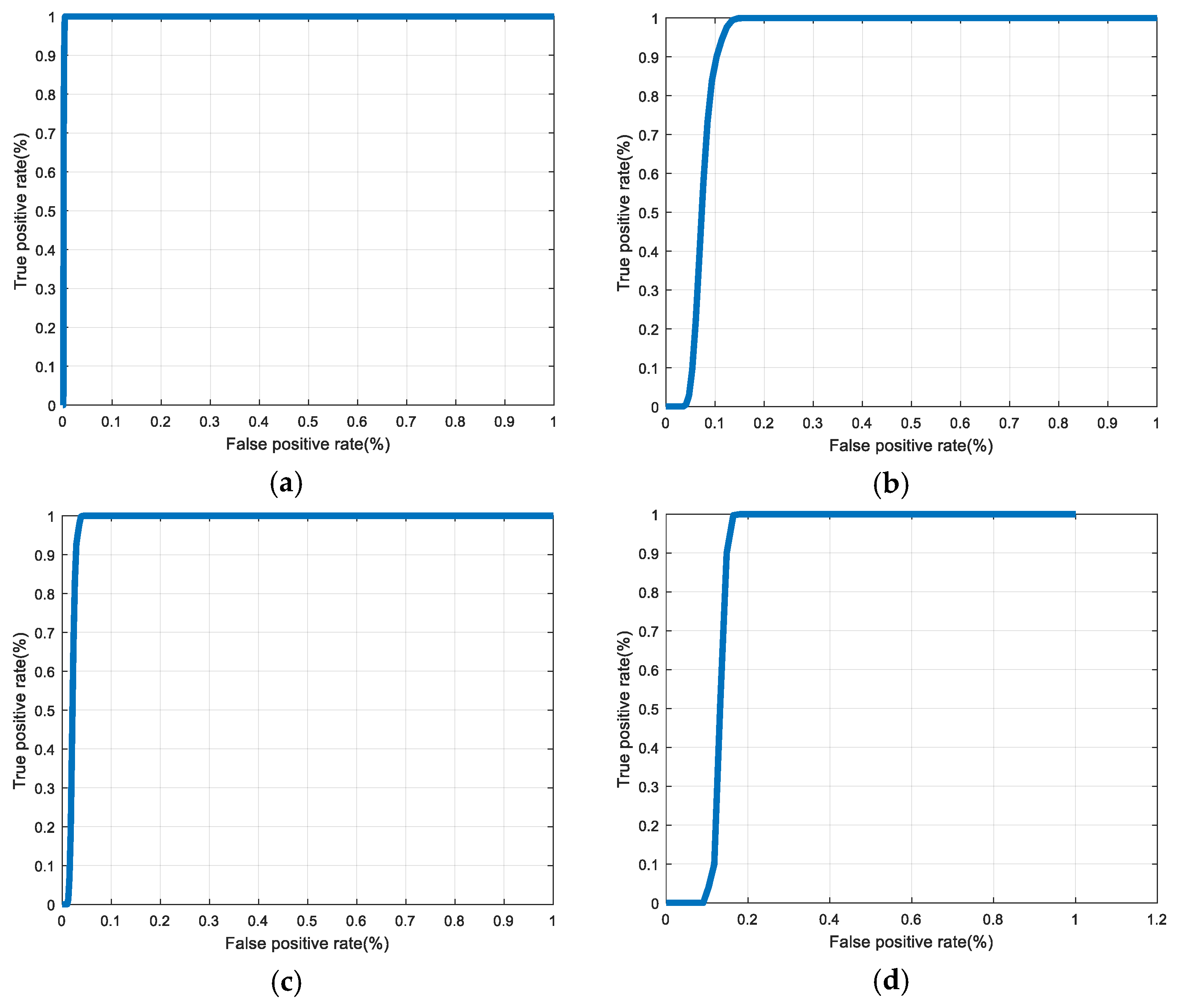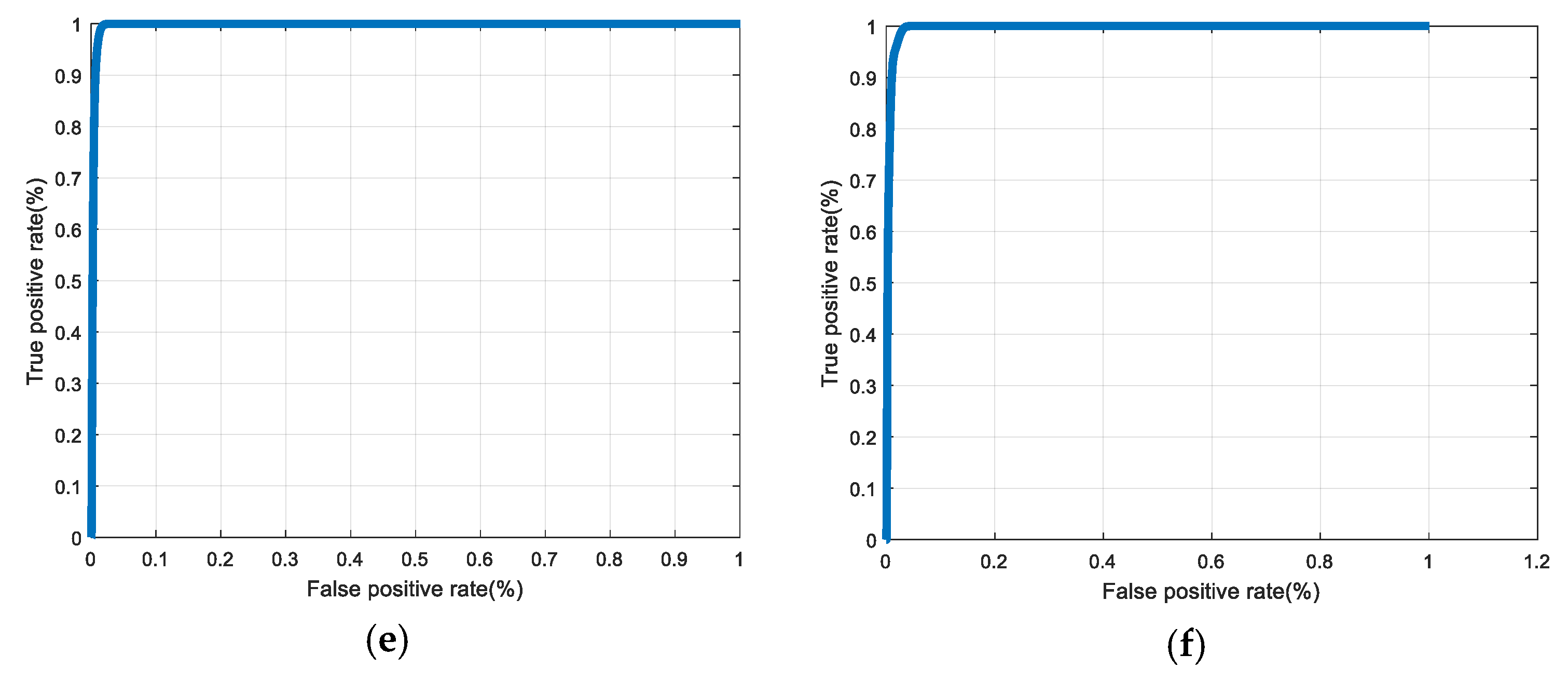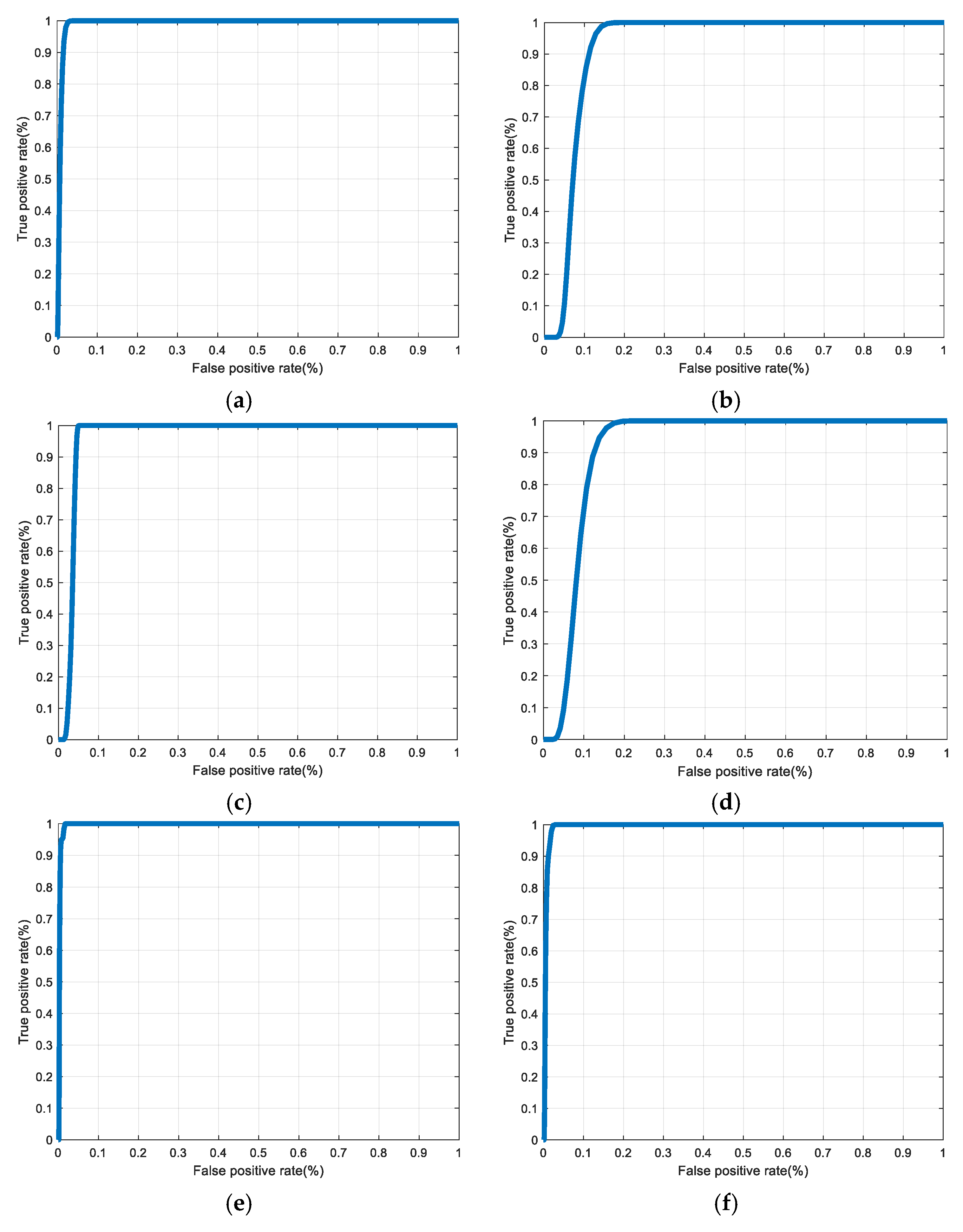Figure 1.
Matrix rotation with an angle .
Figure 1.
Matrix rotation with an angle .
Figure 2.
Proposed method based on a bank of rotations and DWT to generate the cancelable biometric templates.
Figure 2.
Proposed method based on a bank of rotations and DWT to generate the cancelable biometric templates.
Figure 3.
Proposed method based on DCT and a bank of rotations to generate the cancelable biometric templates.
Figure 3.
Proposed method based on DCT and a bank of rotations to generate the cancelable biometric templates.
Figure 4.
Proposed method based on DFT or DFrFT and a bank of rotations to generate the cancelable biometric templates.
Figure 4.
Proposed method based on DFT or DFrFT and a bank of rotations to generate the cancelable biometric templates.
Figure 5.
Samples of ORL database faces used as original biometrics and their histograms. (a) Original biometrics; (b) Biometrics histograms.
Figure 5.
Samples of ORL database faces used as original biometrics and their histograms. (a) Original biometrics; (b) Biometrics histograms.
Figure 6.
Samples of FERET database faces used as original biometrics and their histograms. (a) Original biometrics; (b) Biometrics histograms.
Figure 6.
Samples of FERET database faces used as original biometrics and their histograms. (a) Original biometrics; (b) Biometrics histograms.
Figure 7.
Samples of LFW database faces used as original biometrics and their histograms. (a) Original biometrics; (b) Biometrics histograms.
Figure 7.
Samples of LFW database faces used as original biometrics and their histograms. (a) Original biometrics; (b) Biometrics histograms.
Figure 8.
Samples of the first fingerprints database used as original biometrics and their histograms. (a) Original biometrics; (b) Biometrics histograms.
Figure 8.
Samples of the first fingerprints database used as original biometrics and their histograms. (a) Original biometrics; (b) Biometrics histograms.
Figure 9.
Samples of the second fingerprints database used as original biometrics and their histograms. (a) Original biometrics; (b) Biometrics histograms.
Figure 9.
Samples of the second fingerprints database used as original biometrics and their histograms. (a) Original biometrics; (b) Biometrics histograms.
Figure 10.
Encrypted ORL biometric faces. (a) Rotation in spatial domain; (b) Rotation followed by DWT; (c) Rotation in FFT domain; (d) Rotation in DCT domain; (e) Rotation in FrFT domain [90, 90]; (f) Rotation in FrFT domain [370, 370].
Figure 10.
Encrypted ORL biometric faces. (a) Rotation in spatial domain; (b) Rotation followed by DWT; (c) Rotation in FFT domain; (d) Rotation in DCT domain; (e) Rotation in FrFT domain [90, 90]; (f) Rotation in FrFT domain [370, 370].
Figure 11.
Encrypted FERET biometric faces. (a) Rotation in spatial domain; (b) Rotation followed by DWT; (c) Rotation in FFT domain; (d) Rotation in DCT domain; (e) Rotation in FrFT domain [90, 90]; (f) Rotation in FrFT domain [370, 370].
Figure 11.
Encrypted FERET biometric faces. (a) Rotation in spatial domain; (b) Rotation followed by DWT; (c) Rotation in FFT domain; (d) Rotation in DCT domain; (e) Rotation in FrFT domain [90, 90]; (f) Rotation in FrFT domain [370, 370].
Figure 12.
Encrypted LFW biometric faces. (a) Rotation in spatial domain; (b) Rotation followed by DWT; (c) Rotation in FFT domain; (d) Rotation in DCT domain; (e) Rotation in FrFT domain [90, 90]; (f) Rotation in FrFT domain [370, 370].
Figure 12.
Encrypted LFW biometric faces. (a) Rotation in spatial domain; (b) Rotation followed by DWT; (c) Rotation in FFT domain; (d) Rotation in DCT domain; (e) Rotation in FrFT domain [90, 90]; (f) Rotation in FrFT domain [370, 370].
Figure 13.
Encrypted first biometric fingerprints. (a) Rotation in spatial domain; (b) Rotation followed by DWT; (c) Rotation in FFT domain; (d) Rotation in DCT domain; (e) Rotation in FrFT domain [45, 45]; (f) Rotation in FrFT domain [180, 90].
Figure 13.
Encrypted first biometric fingerprints. (a) Rotation in spatial domain; (b) Rotation followed by DWT; (c) Rotation in FFT domain; (d) Rotation in DCT domain; (e) Rotation in FrFT domain [45, 45]; (f) Rotation in FrFT domain [180, 90].
Figure 14.
Encrypted second biometric fingerprints. (a) Rotation in spatial domain; (b) Rotation followed by DWT; (c) Rotation in FFT domain; (d) Rotation in DCT domain; (e) Rotation in FrFT domain [45, 45]; (f) Rotation in FrFT domain [180, 90].
Figure 14.
Encrypted second biometric fingerprints. (a) Rotation in spatial domain; (b) Rotation followed by DWT; (c) Rotation in FFT domain; (d) Rotation in DCT domain; (e) Rotation in FrFT domain [45, 45]; (f) Rotation in FrFT domain [180, 90].
Figure 15.
Histogram of encrypted images for ORL faces biometrics. (a) Rotation in spatial domain; (b) Rotation followed by DWT; (c) Rotation in FFT domain; (d) Rotation in DCT domain; (e) Rotation in FrFT domain [90, 90]; (f) Rotation in FrFT domain [370, 370].
Figure 15.
Histogram of encrypted images for ORL faces biometrics. (a) Rotation in spatial domain; (b) Rotation followed by DWT; (c) Rotation in FFT domain; (d) Rotation in DCT domain; (e) Rotation in FrFT domain [90, 90]; (f) Rotation in FrFT domain [370, 370].
Figure 16.
Histogram of encrypted images for FERET faces biometrics. (a) Rotation in spatial domain; (b) Rotation followed by DWT; (c) Rotation in FFT domain; (d) Rotation in DCT domain; (e) Rotation in FrFT domain [90, 90]; (f) Rotation in FrFT domain [370, 370].
Figure 16.
Histogram of encrypted images for FERET faces biometrics. (a) Rotation in spatial domain; (b) Rotation followed by DWT; (c) Rotation in FFT domain; (d) Rotation in DCT domain; (e) Rotation in FrFT domain [90, 90]; (f) Rotation in FrFT domain [370, 370].
Figure 17.
Histogram of encrypted images for LFW faces biometrics. (a) Rotation in spatial domain; (b) Rotation followed by DWT; (c) Rotation in FFT domain; (d) Rotation in DCT domain; (e) Rotation in FrFT domain [90, 90]; (f) Rotation in FrFT domain [370, 370].
Figure 17.
Histogram of encrypted images for LFW faces biometrics. (a) Rotation in spatial domain; (b) Rotation followed by DWT; (c) Rotation in FFT domain; (d) Rotation in DCT domain; (e) Rotation in FrFT domain [90, 90]; (f) Rotation in FrFT domain [370, 370].
Figure 18.
Histograms of encrypted images for the first database of the fingerprint biometrics. (a) Rotation in spatial domain; (b) Rotation followed by DWT; (c) Rotation in FFT domain; (d) Rotation in DCT domain; (e) Rotation in FrFT domain [45, 45]; (f) Rotation in FrFT domain [180, 90].
Figure 18.
Histograms of encrypted images for the first database of the fingerprint biometrics. (a) Rotation in spatial domain; (b) Rotation followed by DWT; (c) Rotation in FFT domain; (d) Rotation in DCT domain; (e) Rotation in FrFT domain [45, 45]; (f) Rotation in FrFT domain [180, 90].
Figure 19.
Histograms of encrypted images for the second database of the fingerprint biometrics. (a) Rotation in spatial domain; (b) Rotation followed by DWT; (c) Rotation in FFT domain; (d) Rotation in DCT domain; (e) Rotation in FrFT domain [45, 45]; (f) Rotation in FrFT domain [180, 90].
Figure 19.
Histograms of encrypted images for the second database of the fingerprint biometrics. (a) Rotation in spatial domain; (b) Rotation followed by DWT; (c) Rotation in FFT domain; (d) Rotation in DCT domain; (e) Rotation in FrFT domain [45, 45]; (f) Rotation in FrFT domain [180, 90].
Figure 20.
Correlation scores for authorized patterns of ORL face biometrics. (a) Rotation in spatial domain; (b) Rotation followed by DWT; (c) Rotation in FFT domain; (d) Rotation in DCT domain; (e) Rotation in FrFT domain [90, 90]; (f) Rotation in FrFT domain [370, 370].
Figure 20.
Correlation scores for authorized patterns of ORL face biometrics. (a) Rotation in spatial domain; (b) Rotation followed by DWT; (c) Rotation in FFT domain; (d) Rotation in DCT domain; (e) Rotation in FrFT domain [90, 90]; (f) Rotation in FrFT domain [370, 370].
Figure 21.
Correlation scores for authorized patterns of FERET face biometrics. (a) Rotation in spatial domain; (b) Rotation followed by DWT; (c) Rotation in FFT domain; (d) Rotation in DCT domain; (e) Rotation in FrFT domain [90, 90]; (f) Rotation in FrFT domain [370, 370].
Figure 21.
Correlation scores for authorized patterns of FERET face biometrics. (a) Rotation in spatial domain; (b) Rotation followed by DWT; (c) Rotation in FFT domain; (d) Rotation in DCT domain; (e) Rotation in FrFT domain [90, 90]; (f) Rotation in FrFT domain [370, 370].
Figure 22.
Correlation scores for authorized patterns of LFW face biometrics. (a) Rotation in spatial domain; (b) Rotation followed by DWT; (c) Rotation in FFT domain; (d) Rotation in DCT domain; (e) Rotation in FrFT domain [90, 90]; (f) Rotation in FrFT domain [370, 370].
Figure 22.
Correlation scores for authorized patterns of LFW face biometrics. (a) Rotation in spatial domain; (b) Rotation followed by DWT; (c) Rotation in FFT domain; (d) Rotation in DCT domain; (e) Rotation in FrFT domain [90, 90]; (f) Rotation in FrFT domain [370, 370].
Figure 23.
Correlation scores for authorized patterns of the first database of the fingerprint biometrics. (a) Rotation in spatial domain; (b) Rotation followed by DWT; (c) Rotation in FFT domain; (d) Rotation in DCT domain; (e) Rotation in FrFT domain [45, 45]; (f) Rotation in FrFT domain [180, 90].
Figure 23.
Correlation scores for authorized patterns of the first database of the fingerprint biometrics. (a) Rotation in spatial domain; (b) Rotation followed by DWT; (c) Rotation in FFT domain; (d) Rotation in DCT domain; (e) Rotation in FrFT domain [45, 45]; (f) Rotation in FrFT domain [180, 90].
Figure 24.
Correlation scores for authorized patterns of the second database of the fingerprint biometrics. (a) Rotation in spatial domain; (b) Rotation followed by DWT; (c) Rotation in FFT domain; (d) Rotation in DCT domain; (e) Rotation in FrFT domain [45, 45]; (f) Rotation in FrFT domain [180, 90].
Figure 24.
Correlation scores for authorized patterns of the second database of the fingerprint biometrics. (a) Rotation in spatial domain; (b) Rotation followed by DWT; (c) Rotation in FFT domain; (d) Rotation in DCT domain; (e) Rotation in FrFT domain [45, 45]; (f) Rotation in FrFT domain [180, 90].
Figure 25.
Correlation scores for unauthorized imposter patterns for ORL face biometrics. (a) Rotation in spatial domain; (b) Rotation followed by DWT; (c) Rotation in FFT domain; (d) Rotation in DCT domain; (e) Rotation in FrFT domain [90, 90]; (f) Rotation in FrFT domain [370, 370].
Figure 25.
Correlation scores for unauthorized imposter patterns for ORL face biometrics. (a) Rotation in spatial domain; (b) Rotation followed by DWT; (c) Rotation in FFT domain; (d) Rotation in DCT domain; (e) Rotation in FrFT domain [90, 90]; (f) Rotation in FrFT domain [370, 370].
Figure 26.
Correlation scores for unauthorized patterns of FERET face biometrics. (a) Rotation in spatial domain; (b) Rotation followed by DWT; (c) Rotation in FFT domain; (d) Rotation in DCT domain; (e) Rotation in FrFT domain [90, 90]; (f) Rotation in FrFT domain [370, 370].
Figure 26.
Correlation scores for unauthorized patterns of FERET face biometrics. (a) Rotation in spatial domain; (b) Rotation followed by DWT; (c) Rotation in FFT domain; (d) Rotation in DCT domain; (e) Rotation in FrFT domain [90, 90]; (f) Rotation in FrFT domain [370, 370].
Figure 27.
Correlation scores for unauthorized patterns of LFW face biometrics. (a) Rotation in spatial domain; (b) Rotation followed by DWT; (c) Rotation in FFT domain; (d) Rotation in DCT domain; (e) Rotation in FrFT domain [90, 90]; (f) Rotation in FrFT domain [370, 370].
Figure 27.
Correlation scores for unauthorized patterns of LFW face biometrics. (a) Rotation in spatial domain; (b) Rotation followed by DWT; (c) Rotation in FFT domain; (d) Rotation in DCT domain; (e) Rotation in FrFT domain [90, 90]; (f) Rotation in FrFT domain [370, 370].
Figure 28.
Correlation scores for unauthorized imposter patterns of the first database of the fingerprint biometrics. (a) Rotation in spatial domain; (b) Rotation followed by DWT; (c) Rotation in FFT domain; (d) Rotation in DCT domain; (e) Rotation in FrFT domain [45, 45]; (f) Rotation in FrFT domain [180, 90].
Figure 28.
Correlation scores for unauthorized imposter patterns of the first database of the fingerprint biometrics. (a) Rotation in spatial domain; (b) Rotation followed by DWT; (c) Rotation in FFT domain; (d) Rotation in DCT domain; (e) Rotation in FrFT domain [45, 45]; (f) Rotation in FrFT domain [180, 90].
Figure 29.
Correlation scores for unauthorized imposter patterns of the second database of the fingerprint biometrics. (a) Rotation in spatial domain; (b) Rotation followed by DWT; (c) Rotation in FFT domain; (d) Rotation in DCT domain; (e) Rotation in FrFT domain [45, 45]; (f) Rotation in FrFT domain [180, 90].
Figure 29.
Correlation scores for unauthorized imposter patterns of the second database of the fingerprint biometrics. (a) Rotation in spatial domain; (b) Rotation followed by DWT; (c) Rotation in FFT domain; (d) Rotation in DCT domain; (e) Rotation in FrFT domain [45, 45]; (f) Rotation in FrFT domain [180, 90].
Figure 30.
Probability Distributions Function (PDFs) for ORL face biometrics. (a) Rotation in spatial domain; (b) Rotation followed by DWT; (c) Rotation in FFT domain; (d) Rotation in DCT domain; (e) Rotation in FrFT domain [90, 90]; (f) Rotation in FrFT domain [370, 370].
Figure 30.
Probability Distributions Function (PDFs) for ORL face biometrics. (a) Rotation in spatial domain; (b) Rotation followed by DWT; (c) Rotation in FFT domain; (d) Rotation in DCT domain; (e) Rotation in FrFT domain [90, 90]; (f) Rotation in FrFT domain [370, 370].
Figure 31.
Probability Distributions Function (PDFs) for FERET face biometrics. (a) Rotation in spatial domain; (b) Rotation followed by DWT; (c) Rotation in FFT domain; (d) Rotation in DCT domain; (e) Rotation in FrFT domain [90, 90]; (f) Rotation in FrFT domain [370, 370].
Figure 31.
Probability Distributions Function (PDFs) for FERET face biometrics. (a) Rotation in spatial domain; (b) Rotation followed by DWT; (c) Rotation in FFT domain; (d) Rotation in DCT domain; (e) Rotation in FrFT domain [90, 90]; (f) Rotation in FrFT domain [370, 370].
Figure 32.
Probability Distributions Function (PDFs) for LFW face biometrics. (a) Rotation in spatial domain; (b) Rotation followed by DWT; (c) Rotation in FFT domain; (d) Rotation in DCT domain; (e) Rotation in FrFT domain [90, 90]; (f) Rotation in FrFT domain [370, 370].
Figure 32.
Probability Distributions Function (PDFs) for LFW face biometrics. (a) Rotation in spatial domain; (b) Rotation followed by DWT; (c) Rotation in FFT domain; (d) Rotation in DCT domain; (e) Rotation in FrFT domain [90, 90]; (f) Rotation in FrFT domain [370, 370].
Figure 33.
Probability Distributions Function (PDFs) for the first dataset of the fingerprint biometrics. (a) Rotation in spatial domain; (b) Rotation followed by DWT; (c) Rotation in FFT domain; (d) Rotation in DCT domain; (e) Rotation in FrFT domain [45, 45]; (f) Rotation in FrFT domain [180, 90].
Figure 33.
Probability Distributions Function (PDFs) for the first dataset of the fingerprint biometrics. (a) Rotation in spatial domain; (b) Rotation followed by DWT; (c) Rotation in FFT domain; (d) Rotation in DCT domain; (e) Rotation in FrFT domain [45, 45]; (f) Rotation in FrFT domain [180, 90].
Figure 34.
Probability Distributions Function (PDFs) for the second dataset of the fingerprint biometrics. (a) Rotation in spatial domain; (b) Rotation followed by DWT; (c) Rotation in FFT domain; (d) Rotation in DCT domain; (e) Rotation in FrFT domain [45, 45]; (f) Rotation in FrFT domain [180, 90].
Figure 34.
Probability Distributions Function (PDFs) for the second dataset of the fingerprint biometrics. (a) Rotation in spatial domain; (b) Rotation followed by DWT; (c) Rotation in FFT domain; (d) Rotation in DCT domain; (e) Rotation in FrFT domain [45, 45]; (f) Rotation in FrFT domain [180, 90].
Figure 35.
ROC curves for ORL face biometrics. (a) Rotation in spatial domain; (b) Rotation followed by DWT; (c) Rotation in FFT domain; (d) Rotation in DCT domain; (e) Rotation in FrFT domain [90, 90]; (f) Rotation in FrFT domain [370, 370].
Figure 35.
ROC curves for ORL face biometrics. (a) Rotation in spatial domain; (b) Rotation followed by DWT; (c) Rotation in FFT domain; (d) Rotation in DCT domain; (e) Rotation in FrFT domain [90, 90]; (f) Rotation in FrFT domain [370, 370].
Figure 36.
ROC curves for FERET face biometrics. (a) Rotation in spatial domain; (b) Rotation followed by DWT; (c) Rotation in FFT domain; (d) Rotation in DCT domain; (e) Rotation in FrFT domain [90, 90]; (f) Rotation in FrFT domain [370, 370].
Figure 36.
ROC curves for FERET face biometrics. (a) Rotation in spatial domain; (b) Rotation followed by DWT; (c) Rotation in FFT domain; (d) Rotation in DCT domain; (e) Rotation in FrFT domain [90, 90]; (f) Rotation in FrFT domain [370, 370].
Figure 37.
ROC curves for LFW face biometrics. (a) Rotation in spatial domain; (b) Rotation followed by DWT; (c) Rotation in FFT domain; (d) Rotation in DCT domain; (e) Rotation in FrFT domain [90, 90]; (f) Rotation in FrFT domain [370, 370].
Figure 37.
ROC curves for LFW face biometrics. (a) Rotation in spatial domain; (b) Rotation followed by DWT; (c) Rotation in FFT domain; (d) Rotation in DCT domain; (e) Rotation in FrFT domain [90, 90]; (f) Rotation in FrFT domain [370, 370].
Figure 38.
ROC curves for the first dataset of the fingerprint biometrics. (a) Rotation in spatial domain; (b) Rotation followed by DWT; (c) Rotation in FFT domain; (d) Rotation in DCT domain; (e) Rotation in FrFT domain [45, 45]; (f) Rotation in FrFT domain [180, 90].
Figure 38.
ROC curves for the first dataset of the fingerprint biometrics. (a) Rotation in spatial domain; (b) Rotation followed by DWT; (c) Rotation in FFT domain; (d) Rotation in DCT domain; (e) Rotation in FrFT domain [45, 45]; (f) Rotation in FrFT domain [180, 90].
Figure 39.
ROC curves for the second dataset of the fingerprint biometrics. (a) Rotation in spatial domain; (b) Rotation followed by DWT; (c) Rotation in FFT domain; (d) Rotation in DCT domain; (e) Rotation in FrFT domain [45, 45]; (f) Rotation in FrFT domain [180, 90].
Figure 39.
ROC curves for the second dataset of the fingerprint biometrics. (a) Rotation in spatial domain; (b) Rotation followed by DWT; (c) Rotation in FFT domain; (d) Rotation in DCT domain; (e) Rotation in FrFT domain [45, 45]; (f) Rotation in FrFT domain [180, 90].
Table 1.
Comparative results of the recognition methods on the ORL faces dataset.
Table 1.
Comparative results of the recognition methods on the ORL faces dataset.
| Method | AROC | Mean of Authorized Correlation Score | Mean of Un-Authorized Correlation Score | FAR | FRR | ERR |
|---|
| Cancelable based rotation | 0.9986 | 0.9286 | 0.7725 | 0.0047 | 0.0024 | 0.0018 |
| Rotation followed by DWT | 0.9244 | 0.7041 | 0.0024 | 0.135 | 0.0228 | 0.0144 |
| Rotation in FFT domain | 0.9784 | 0.7984 | −0.0152 | 0.0381 | 0.0209 | 0.0106 |
| Rotation based on DCT | 0.8681 | 0.7228 | −0.0019 | 0.1641 | 0.1000 | 0.0568 |
| Rotation based on FrFT [90, 90] | 0.9969 | 0.907 | −0.0897 | 0.0173 | 0.0112 | 0.0055 |
| Rotation based on FrFT [180, 180] | 0.9967 | 0.8968 | −0.0092 | 0.0125 | 0.0104 | 0.005 |
| Rotation based on FrFT [370, 370] | 0.9952 | 0.8976 | −0.0320 | 0.0311 | 0.0149 | 0.0072 |
Table 2.
Comparative results of the recognition methods on the FERET faces dataset.
Table 2.
Comparative results of the recognition methods on the FERET faces dataset.
| Method | AROC | Mean of Authorized Correlation Score | Mean of Un-Authorized Correlation Score | FAR | FRR | ERR |
|---|
| Cancelable based rotation | 0.9920 | 0.8802 | 0.5490 | 0.0266 | 0.0212 | 0.0107 |
| Rotation followed by DWT | 0.9236 | 0.6961 | −0.0012 | 0.1424 | 0.0354 | 0.0184 |
| Rotation in FFT domain | 0.9657 | 0.7788 | 0.0182 | 0.0497 | 0.0075 | 0.0042 |
| Rotation based on DCT | 0.914 | 0.751 | −0.0017 | 0.1559 | 0.0536 | 0.0245 |
| Rotation based on FrFT [90, 90] | 0.9965 | 0.8810 | 0.0628 | 0.0171 | 0.0159 | 0.0091 |
| Rotation based on FrFT [180, 180] | 0.9964 | 0.8971 | −0.0087 | 0.0159 | 0.0130 | 0.007 |
| Rotation based on FrFT [370, 370] | 0.9941 | 0.8864 | 0.1304 | 0.0238 | 0.0220 | 0.0120 |
Table 3.
Comparative results of the recognition methods on the LFW faces dataset.
Table 3.
Comparative results of the recognition methods on the LFW faces dataset.
| Method | AROC | Mean of Authorized Correlation Score | Mean of Un-Authorized Correlation Score | FAR | FRR | ERR |
|---|
| Cancelable based rotation | 0.9953 | 0.9199 | 0.8104 | 0.0190 | 0.0182 | 0.0109 |
| Rotation followed by DWT | 0.9363 | 0.7103 | −0.0032 | 0.1118 | 0.0161 | 0.0088 |
| Rotation in FFT domain | 0.9404 | 0.7921 | 0.0100 | 0.1592 | 0.0419 | 0.0201 |
| Rotation based on DCT | 0.9581 | 0.7462 | −0.0007 | 0.0749 | 0.0258 | 0.0158 |
| Rotation based on FrFT [90, 90] | 0.9561 | 0.8231 | 0.2578 | 0.0973 | 0.0254 | 0.0172 |
| Rotation based on FrFT [180, 180] | 0.9965 | 0.8966 | −0.0089 | 0.0131 | 0.0114 | 0.008 |
| Rotation based on FrFT [370, 370] | 0.9966 | 0.9015 | 0.0616 | 0.0081 | 0.0418 | 0.0213 |
Table 4.
Comparative results of the recognition methods on the first fingerprint database.
Table 4.
Comparative results of the recognition methods on the first fingerprint database.
| Method | AROC | Mean of Authorized Correlation Score | Mean of Un-Authorized Correlation Score | FAR | FRR | ERR |
|---|
| Cancelable based rotation | 0.993 | 0.91 | 0.876 | 0.026 | 0.017 | 0.010 |
| Rotation followed by DWT | 0.925 | 0.6777 | 0.0004 | 0.131 | 0.028 | 0.0187 |
| Rotation in FFT domain | 0.953 | 0.7699 | 0.2135 | 0.104 | 0.014 | 0.0130 |
| Rotation based on DCT | 0.963 | 0.772 | 0.0552 | 0.042 | 0.644 | 0.3251 |
| Rotation based on FrFT [45, 45] | 0.901 | 0.7420 | 0.3009 | 0.194 | 0.057 | 0.0278 |
| Rotation based on FrFT [180, 180] | 0.991 | 0.8879 | 0.0521 | 0.039 | 0.014 | 0.0076 |
| Rotation based on FrFT [180, 90] | 0.997 | 0.8980 | −0.0751 | 0.012 | 0.010 | 0.0052 |
Table 5.
Comparative results of the recognition methods on the second fingerprint database.
Table 5.
Comparative results of the recognition methods on the second fingerprint database.
| Method | AROC | Mean of Authorized Correlation Score | Mean of Un-Authorized Correlation Score | FAR | FRR | ERR |
|---|
| Cancelable based rotation | 0.9974 | 0.9338 | 0.8841 | 0.008 | 0.003 | 0.0030 |
| Rotation followed by DWT | 0.9474 | 0.6771 | 0.0042 | 0.076 | 0.010 | 0.0081 |
| Rotation in FFT domain | 0.9667 | 0.7623 | 0.2271 | 0.060 | 0.018 | 0.0097 |
| Rotation based on DCT | 0.9608 | 0.7596 | 0.5771 | 0.044 | 0.035 | 0.0183 |
| Rotation based on FrFT [45, 45] | 0.8683 | 0.7412 | 0.3049 | 0.203 | 0.038 | 0.0264 |
| Rotation based on FrFT [180, 180] | 0.9909 | 0.8882 | 0.0531 | 0.037 | 0.015 | 0.0072 |
| Rotation based on FrFT [180, 90] | 0.997 | 0.8913 | 0.0120 | 0.010 | 0.003 | 0.0026 |
Table 6.
The average statistical evaluation results for the proposed and traditional cancellable biometric methods [
19,
31,
34,
51,
52,
53,
54,
55].
Table 6.
The average statistical evaluation results for the proposed and traditional cancellable biometric methods [
19,
31,
34,
51,
52,
53,
54,
55].
Cancellable
Biometric Method | EER | FAR | FRR | AROC |
|---|
| Proposed | 0.0023 | 0.008 | 0.003 | 0.998 |
| Ref. [19] | 0.0924 | 0.0562 | 0.0257 | 0.868 |
| Ref. [31] | 0.0178 | 0.0071 | 0.0876 | 0.896 |
| Ref. [34] | 0.0098 | 0.0104 | 0.018 | 0.952 |
| Ref. [51] | 0.1081 | 0.0927 | 0.0967 | 0.907 |
| Ref. [52] | 0.0416 | 0.1955 | 0.0489 | 0.873 |
| Ref. [53] | 0.0859 | 0.0435 | 0.0627 | 0.718 |
| Ref. [54] | 0.0357 | 0.0985 | 0.0612 | 0.863 |
| Ref. [55] | 0.0046 | 0.0235 | 0.0929 | 0.883 |
